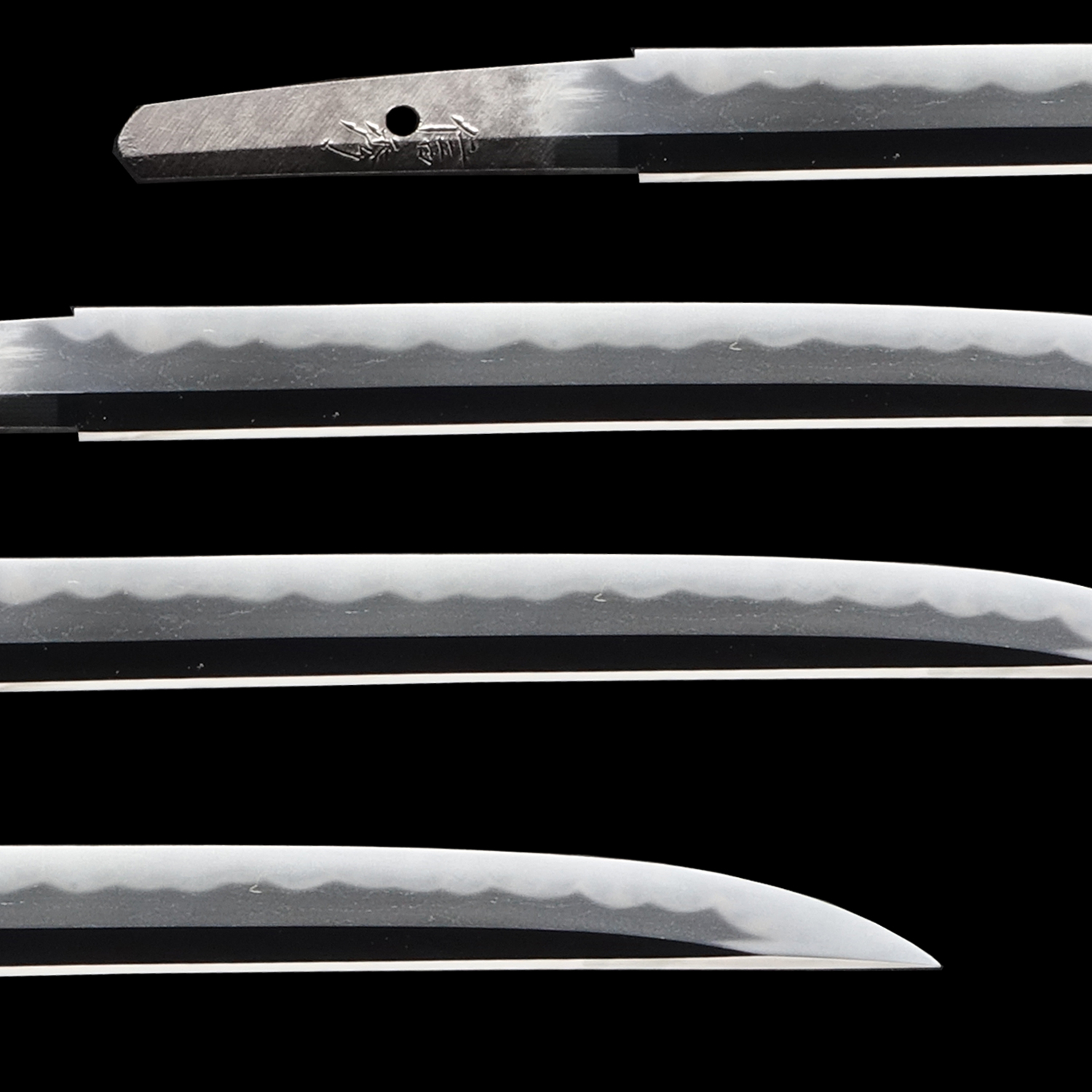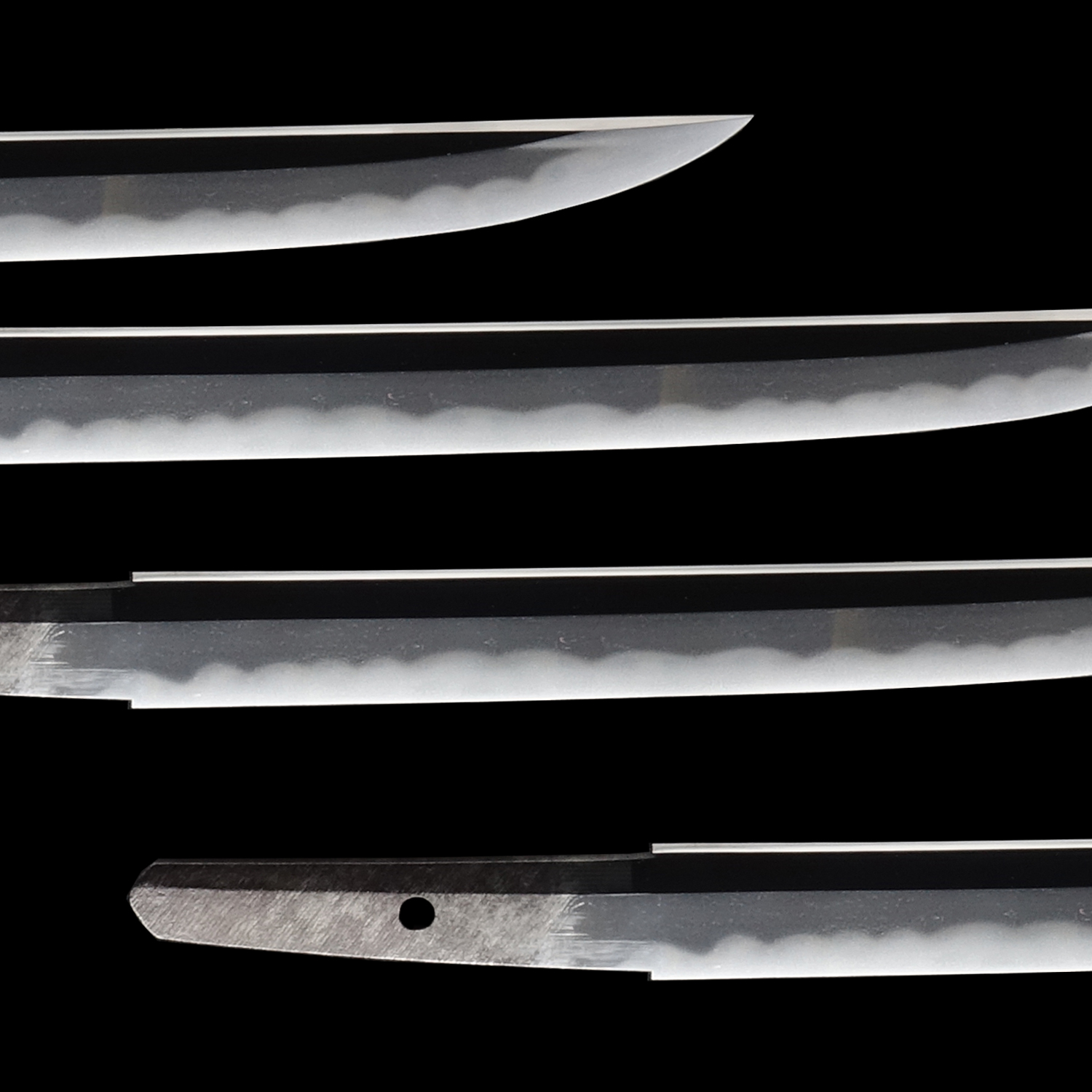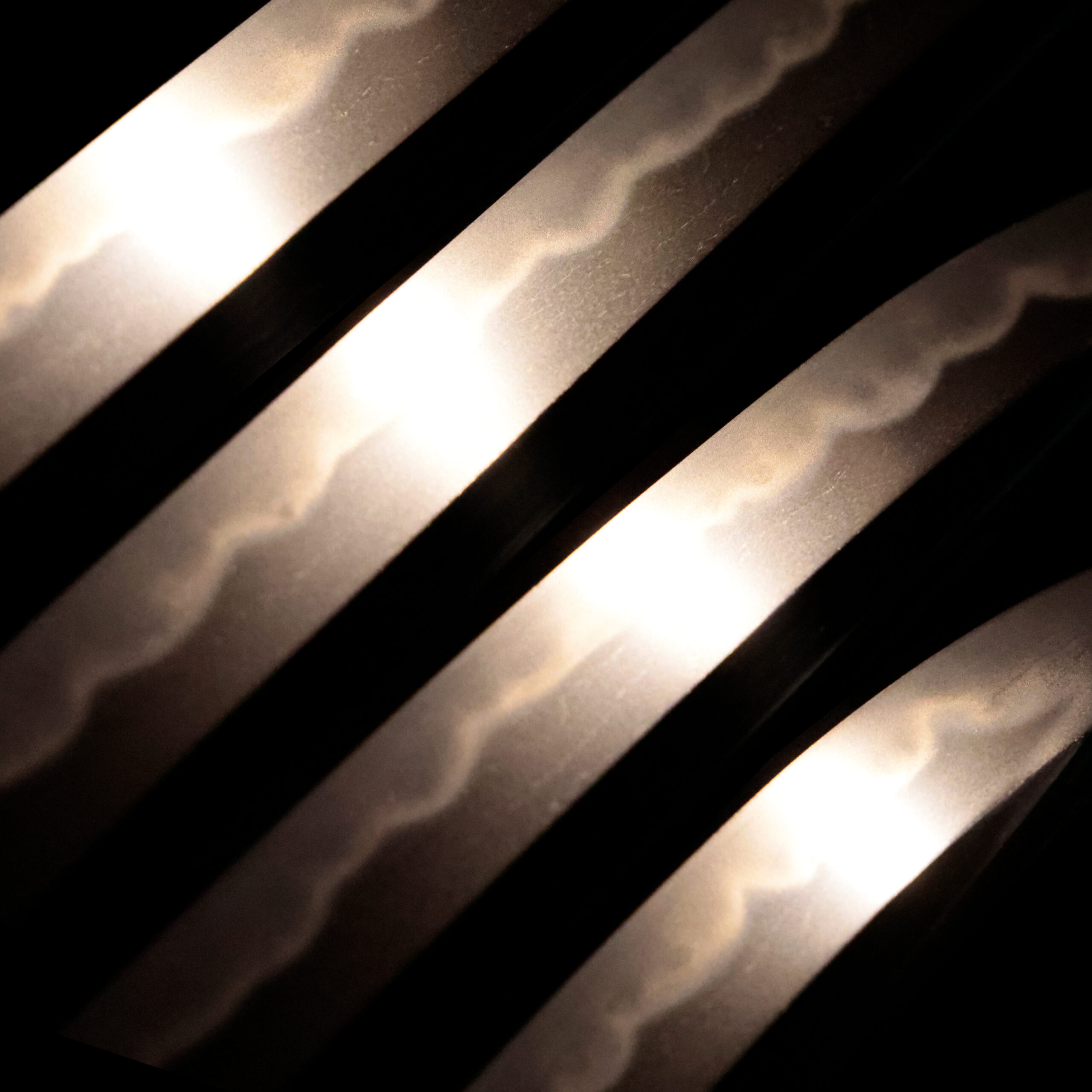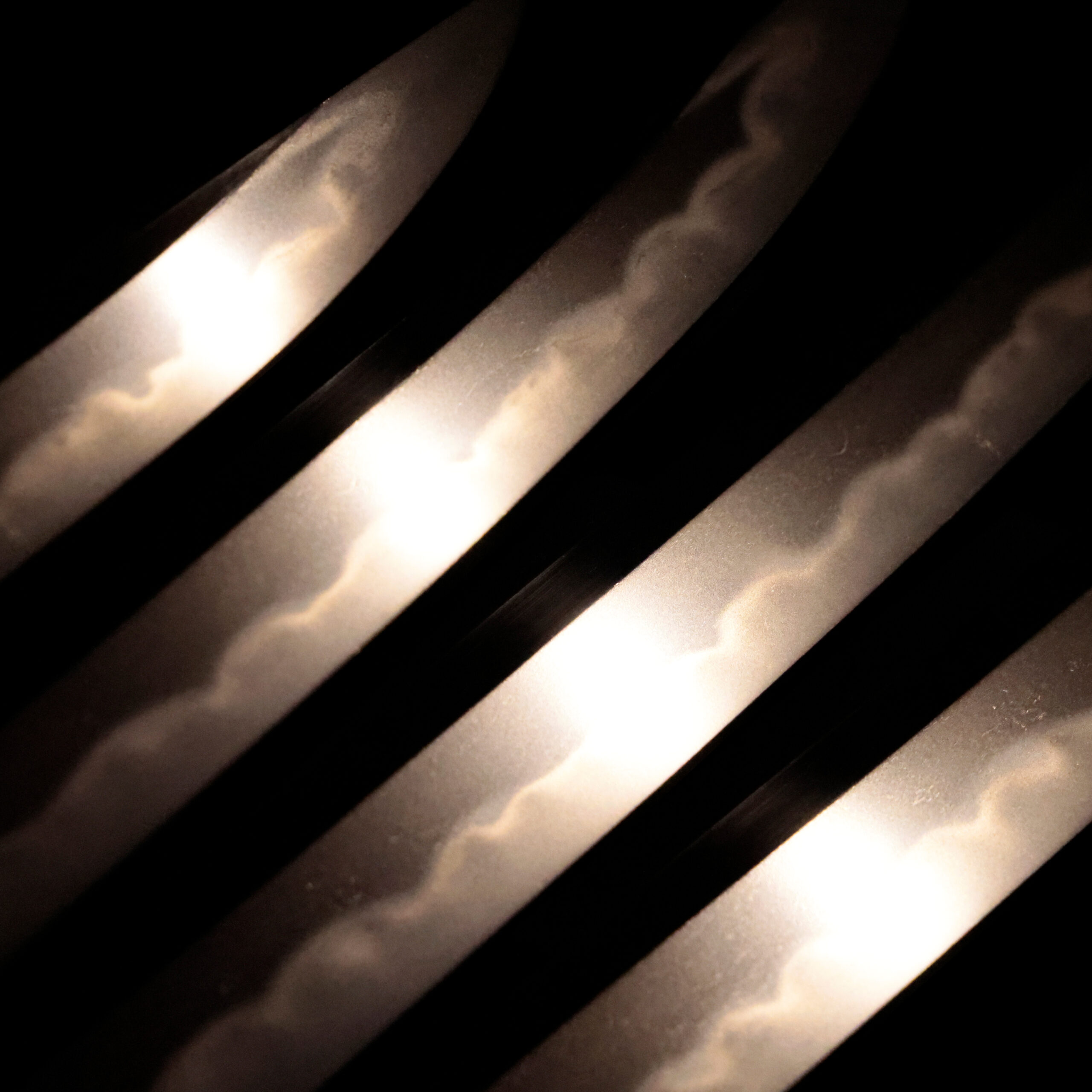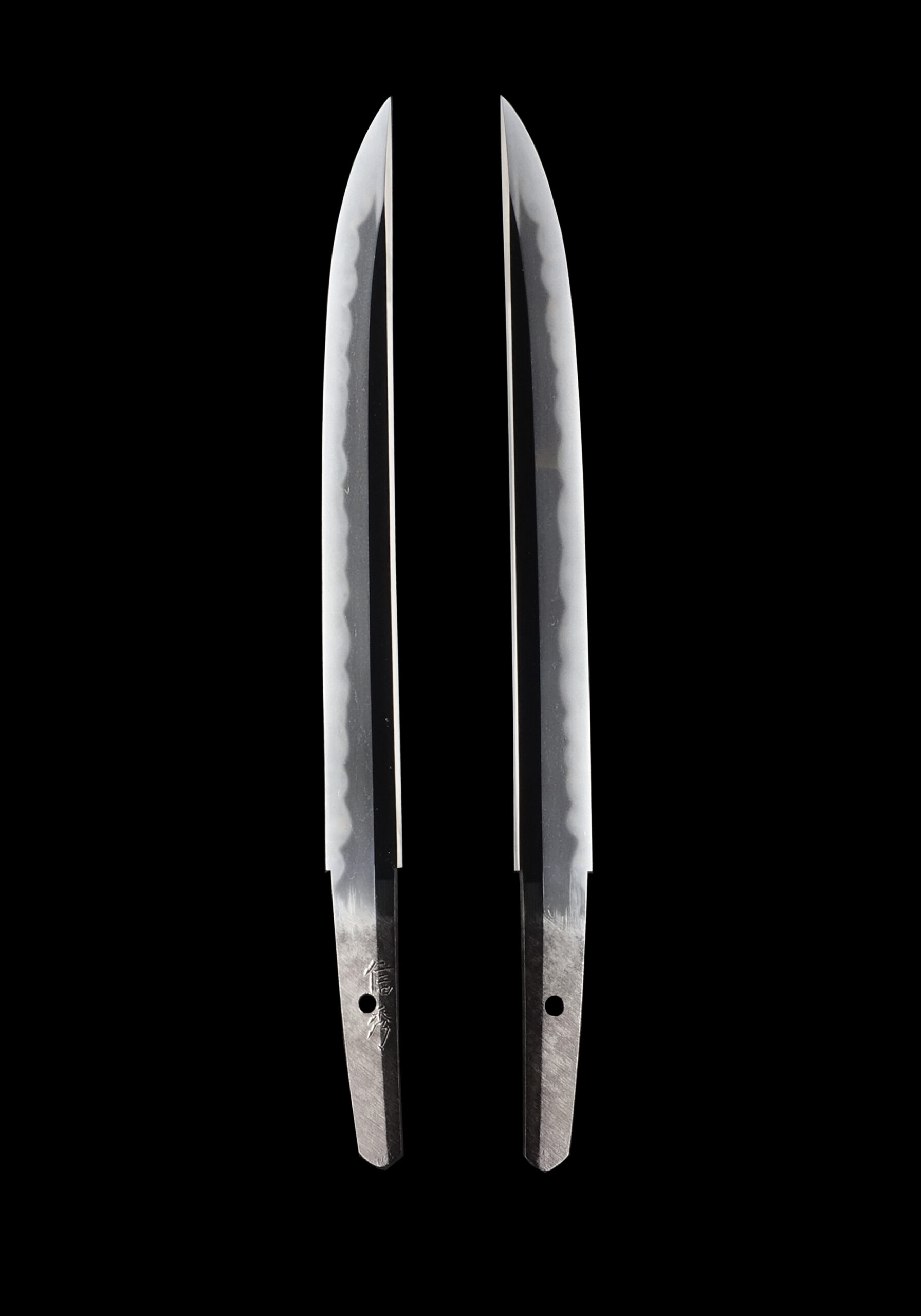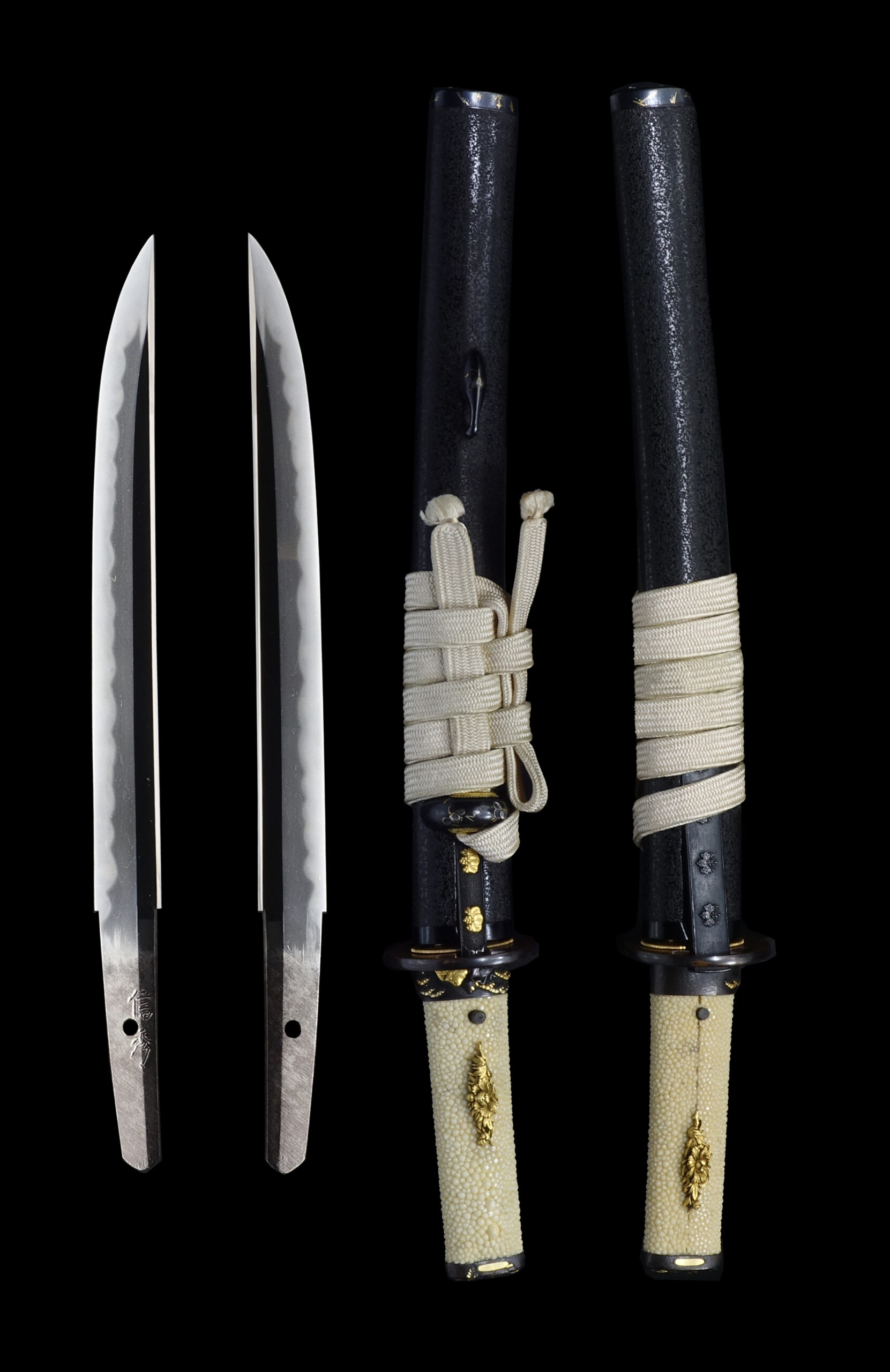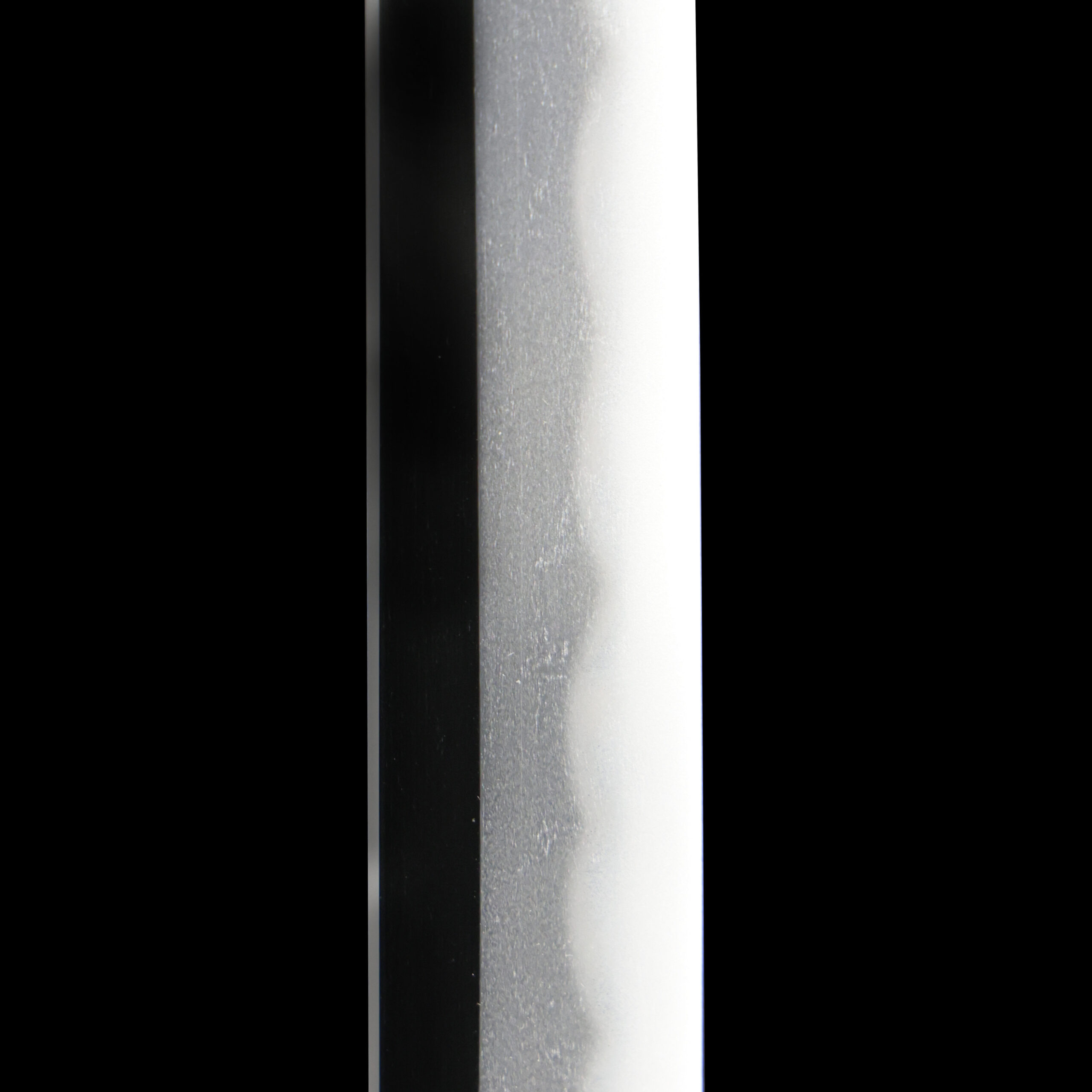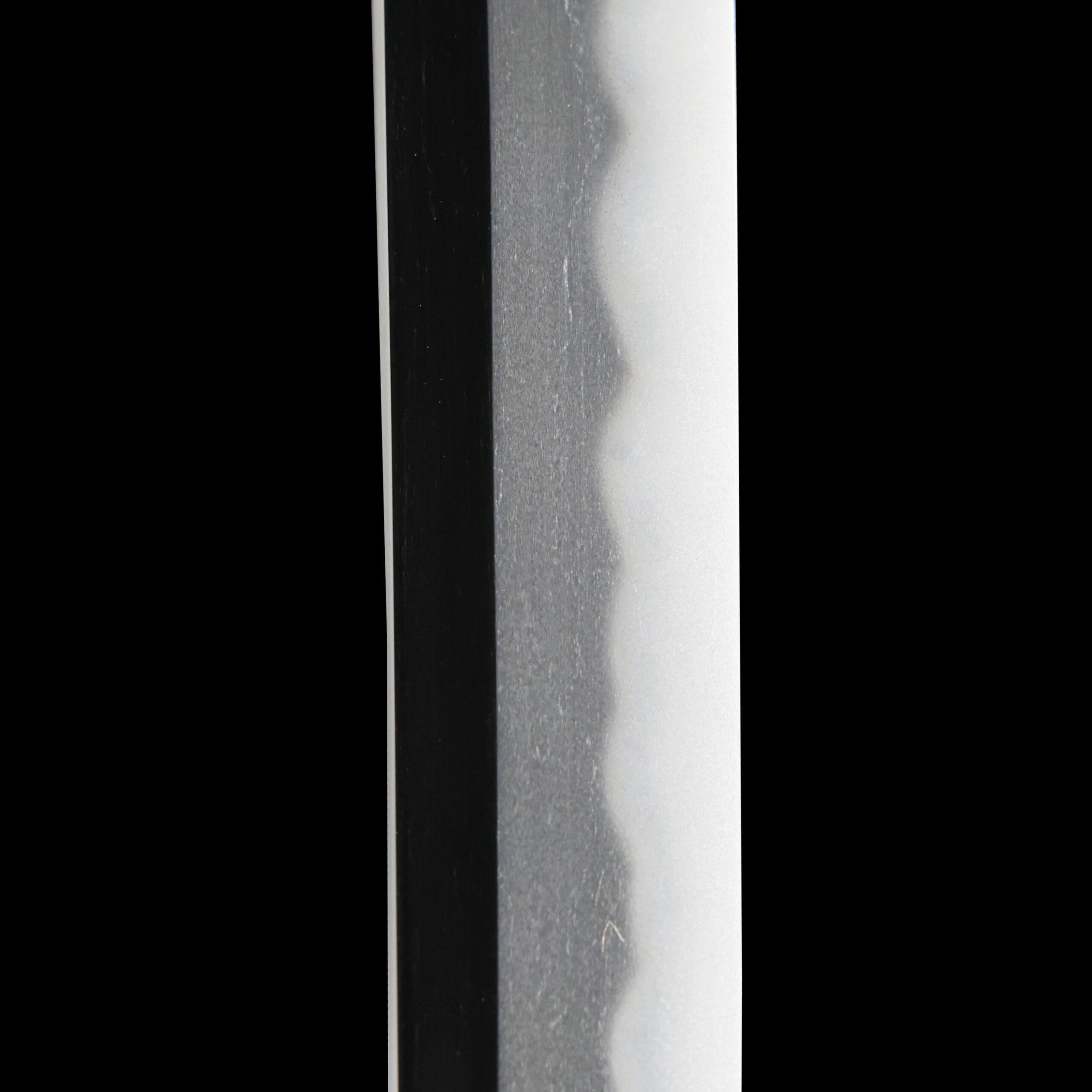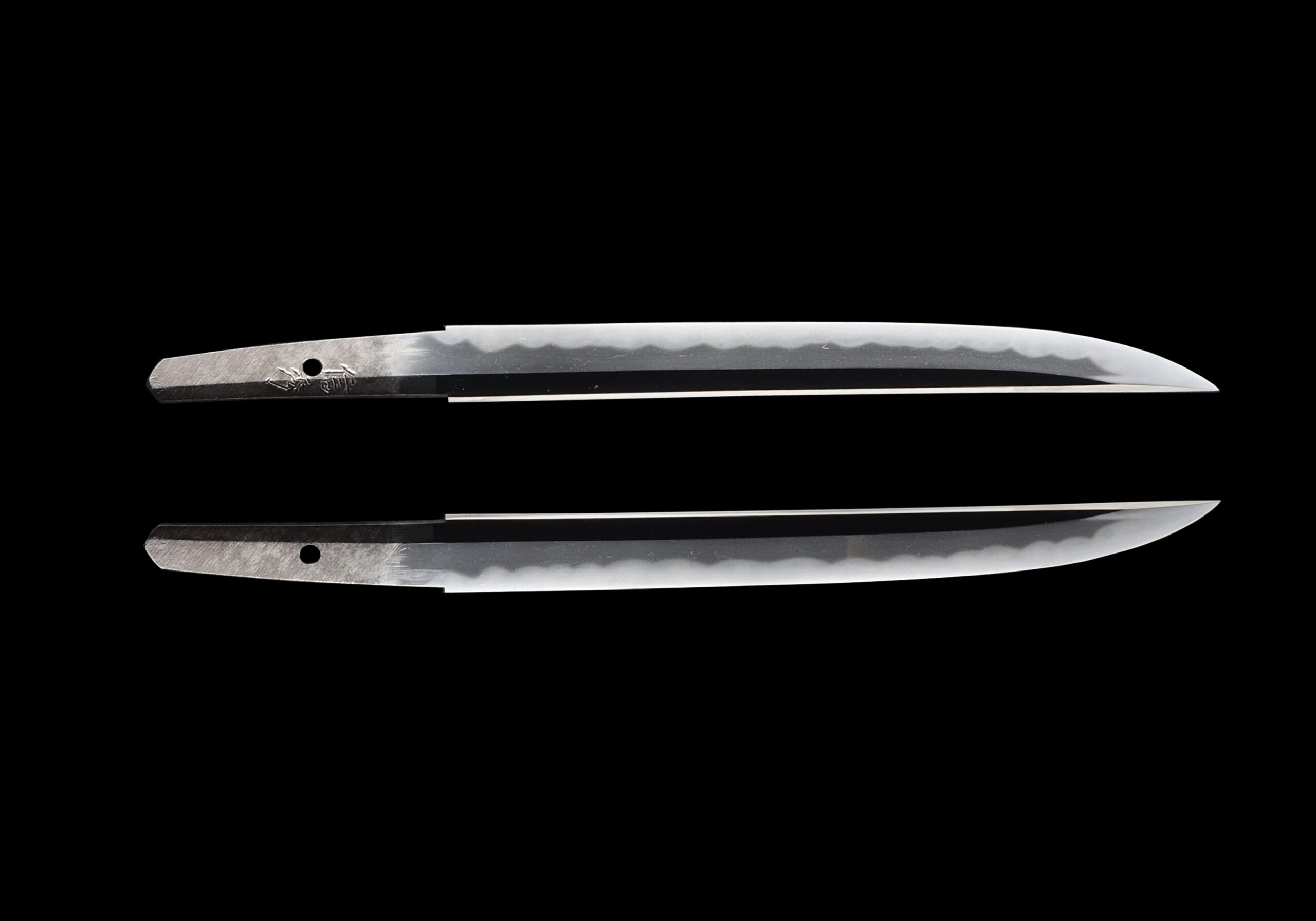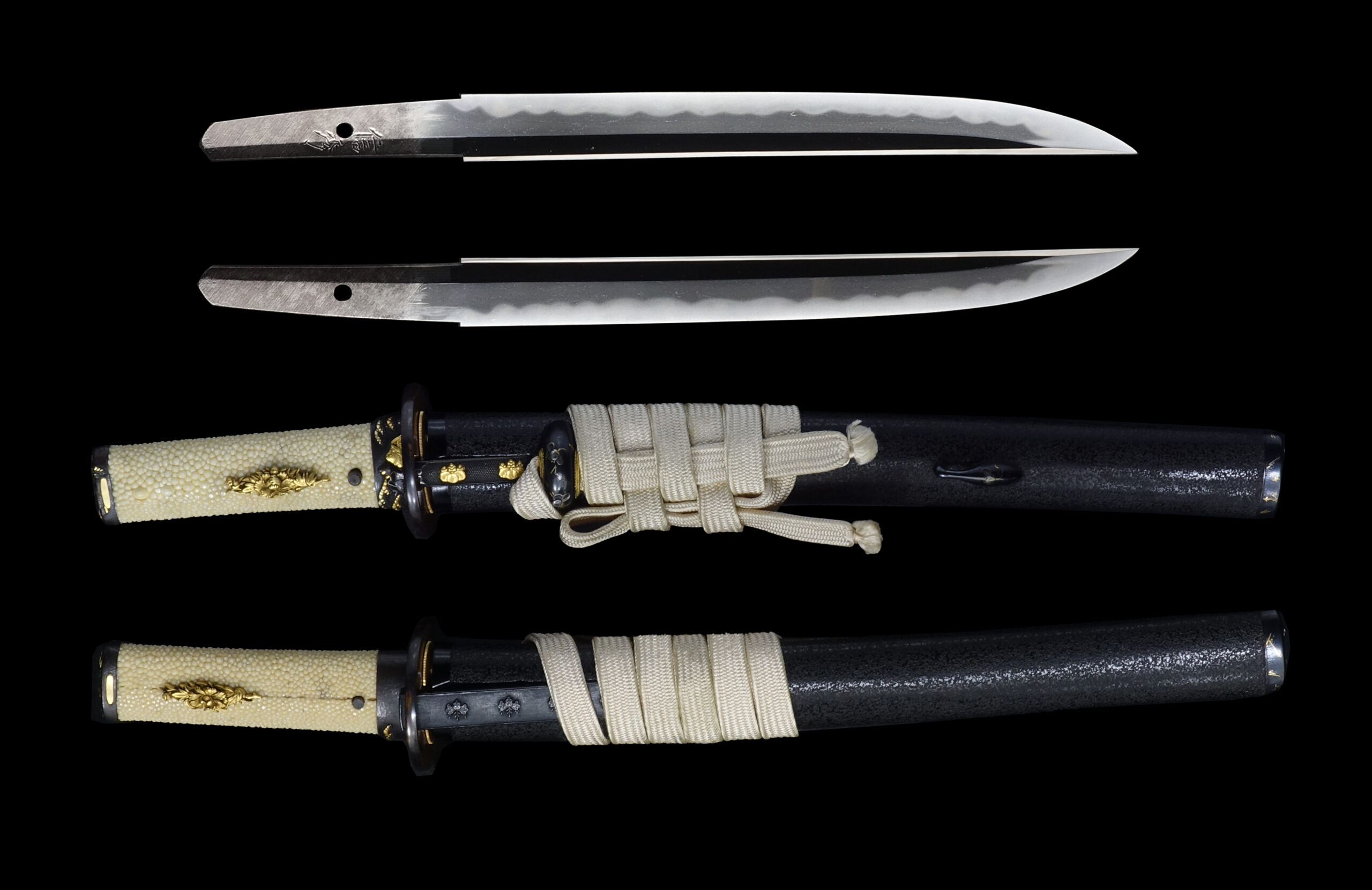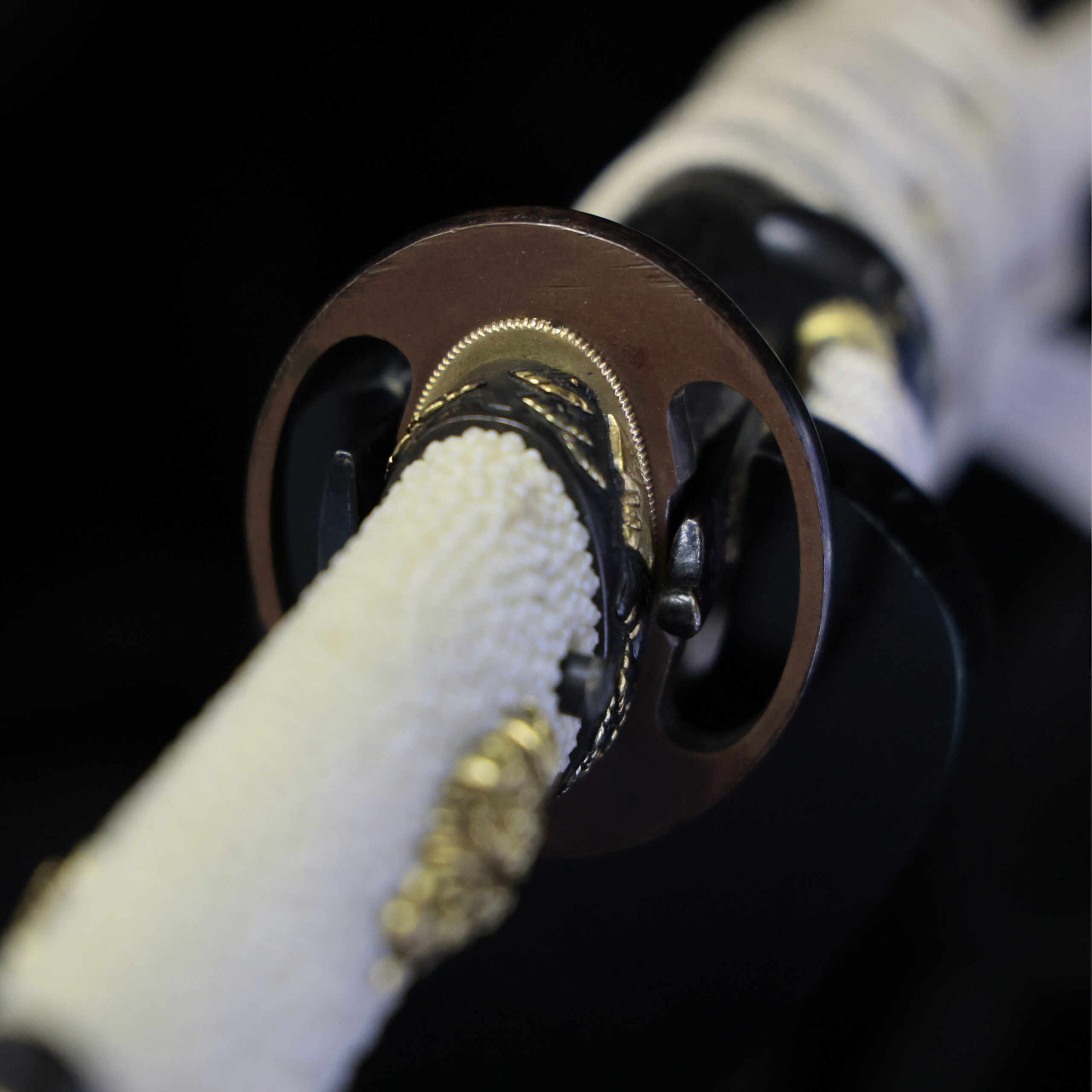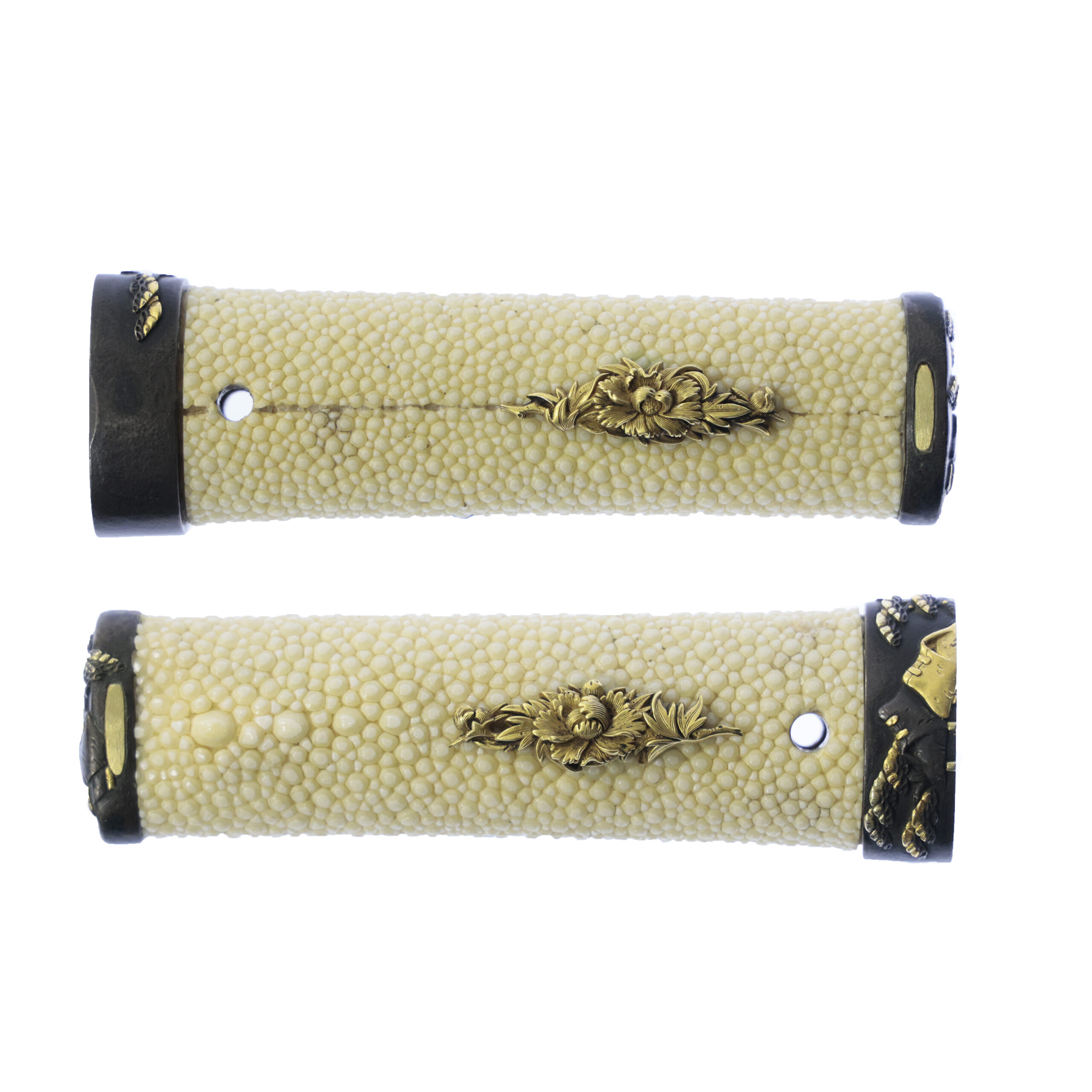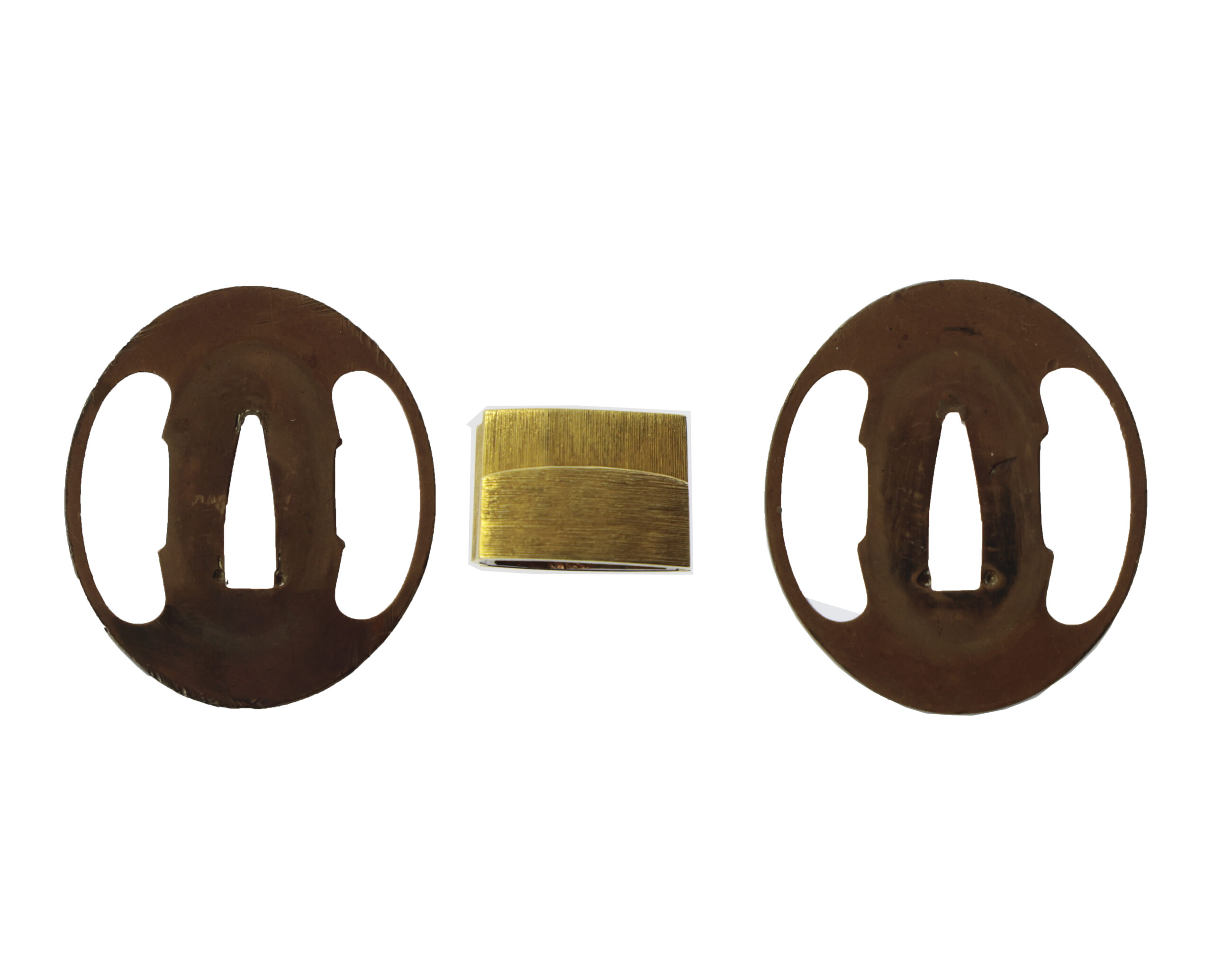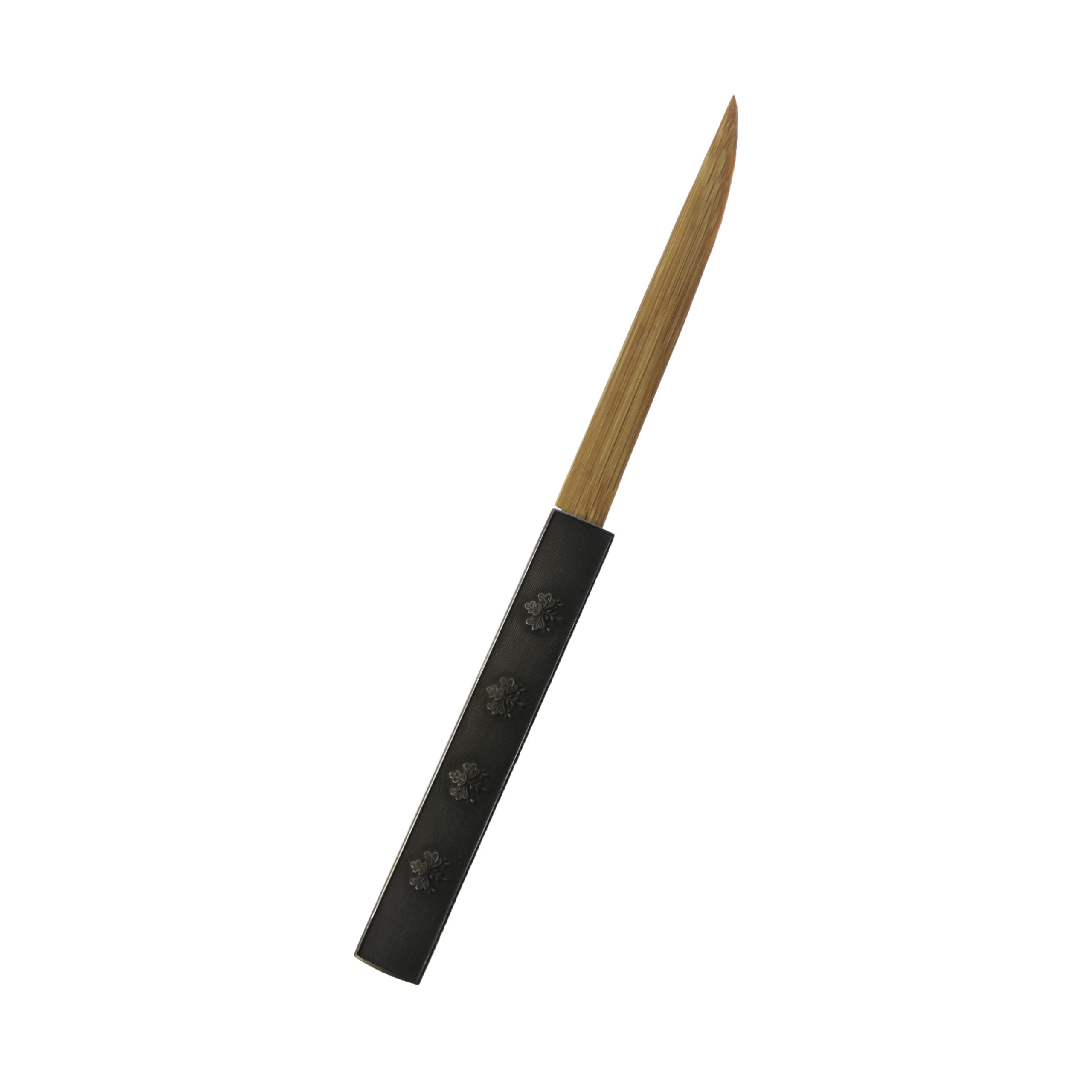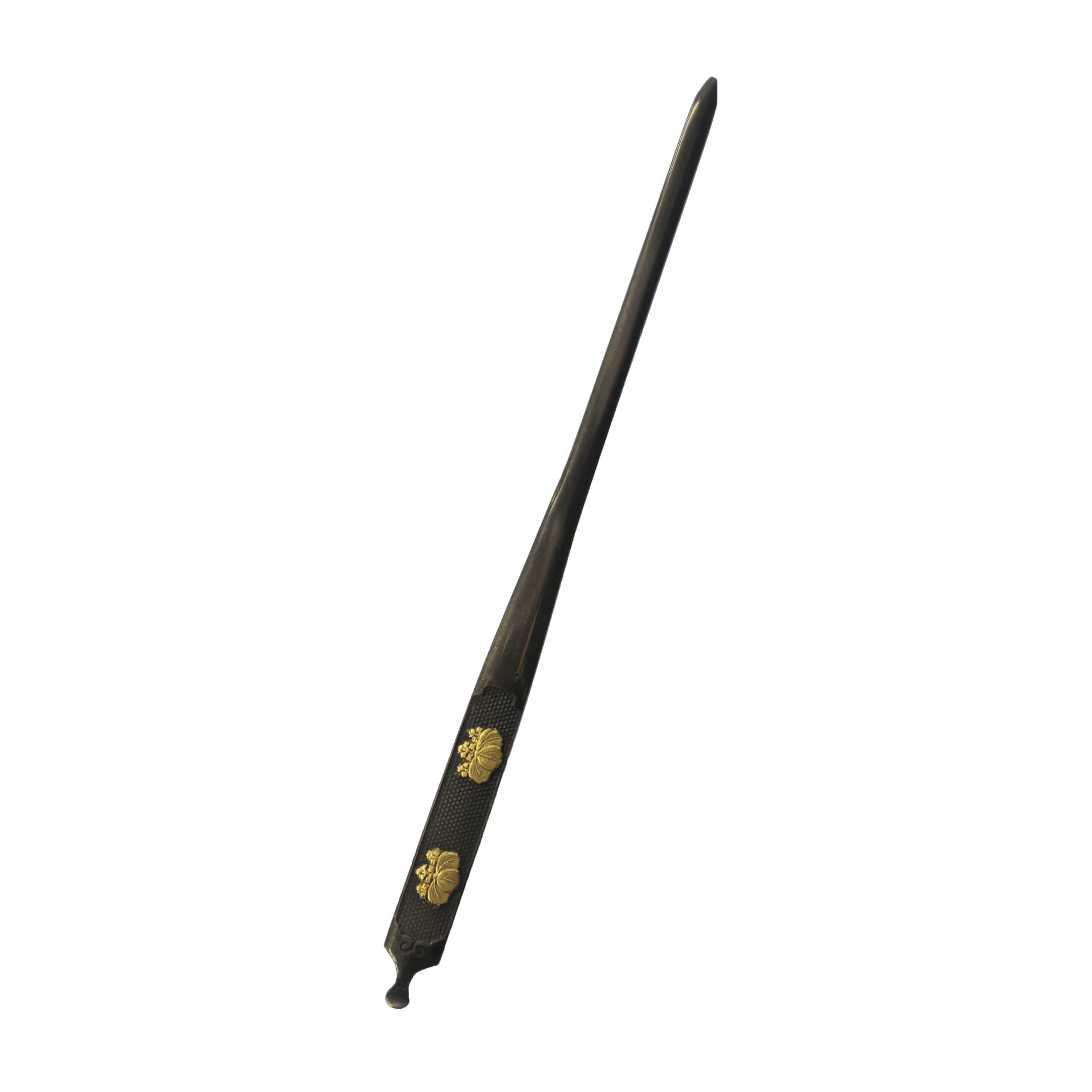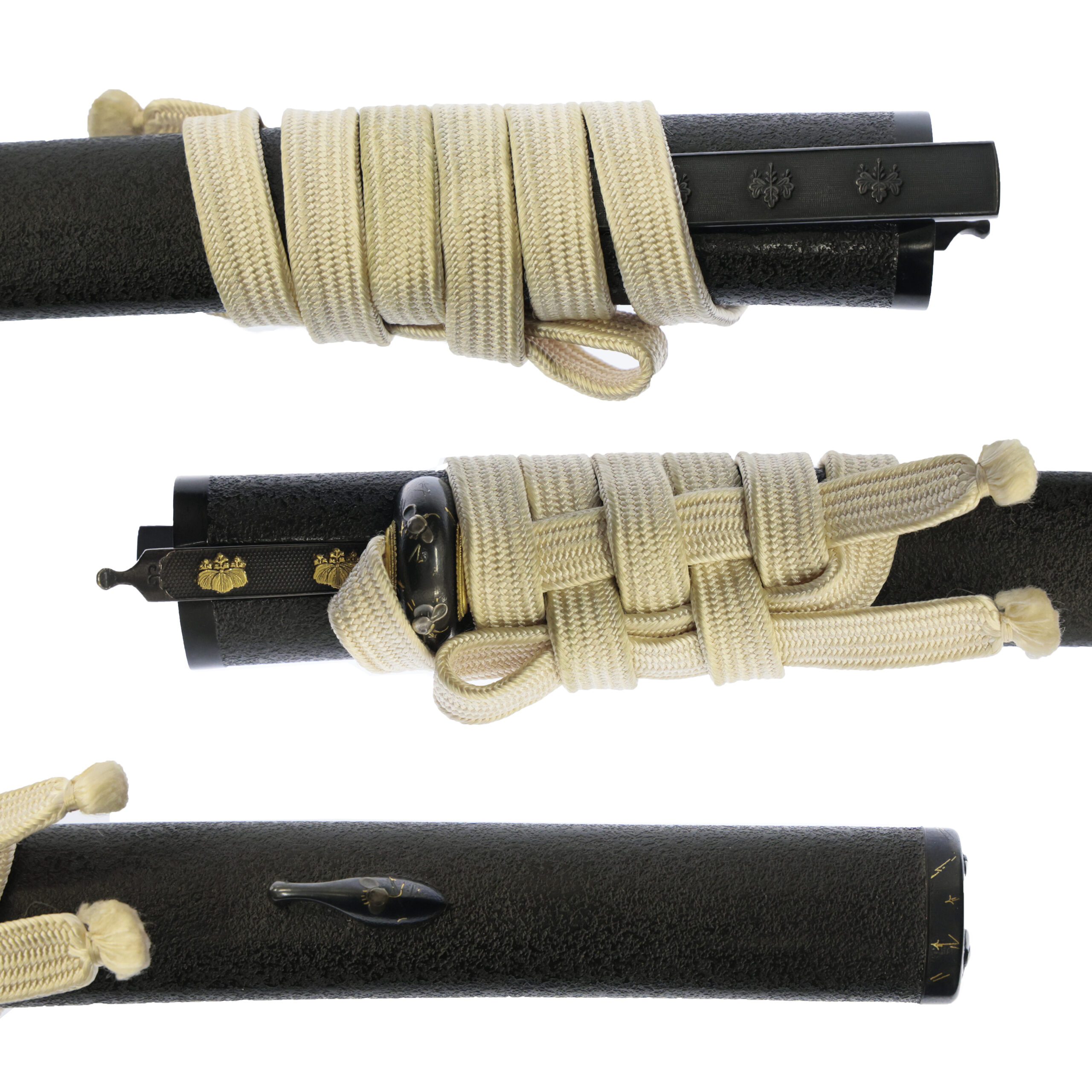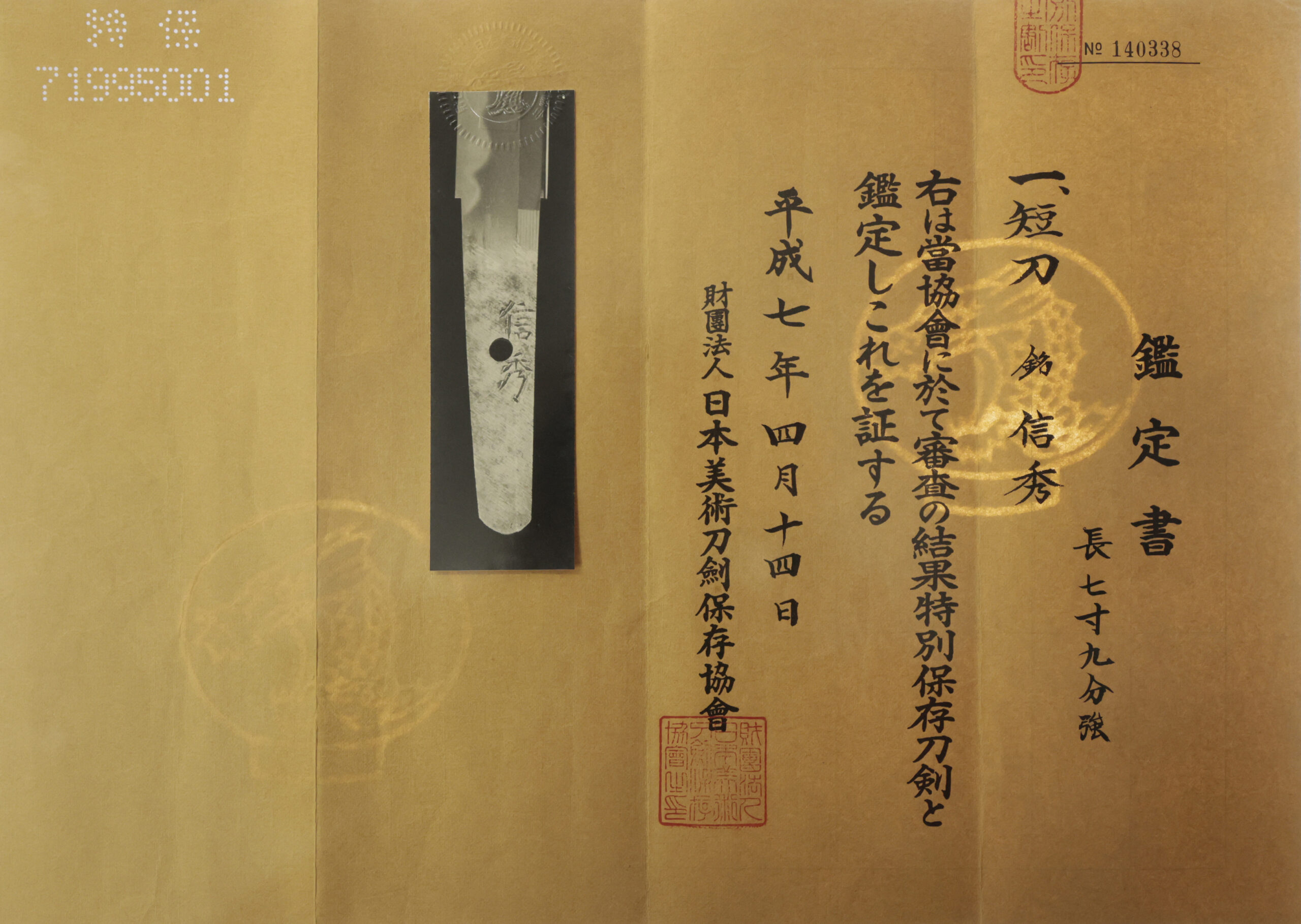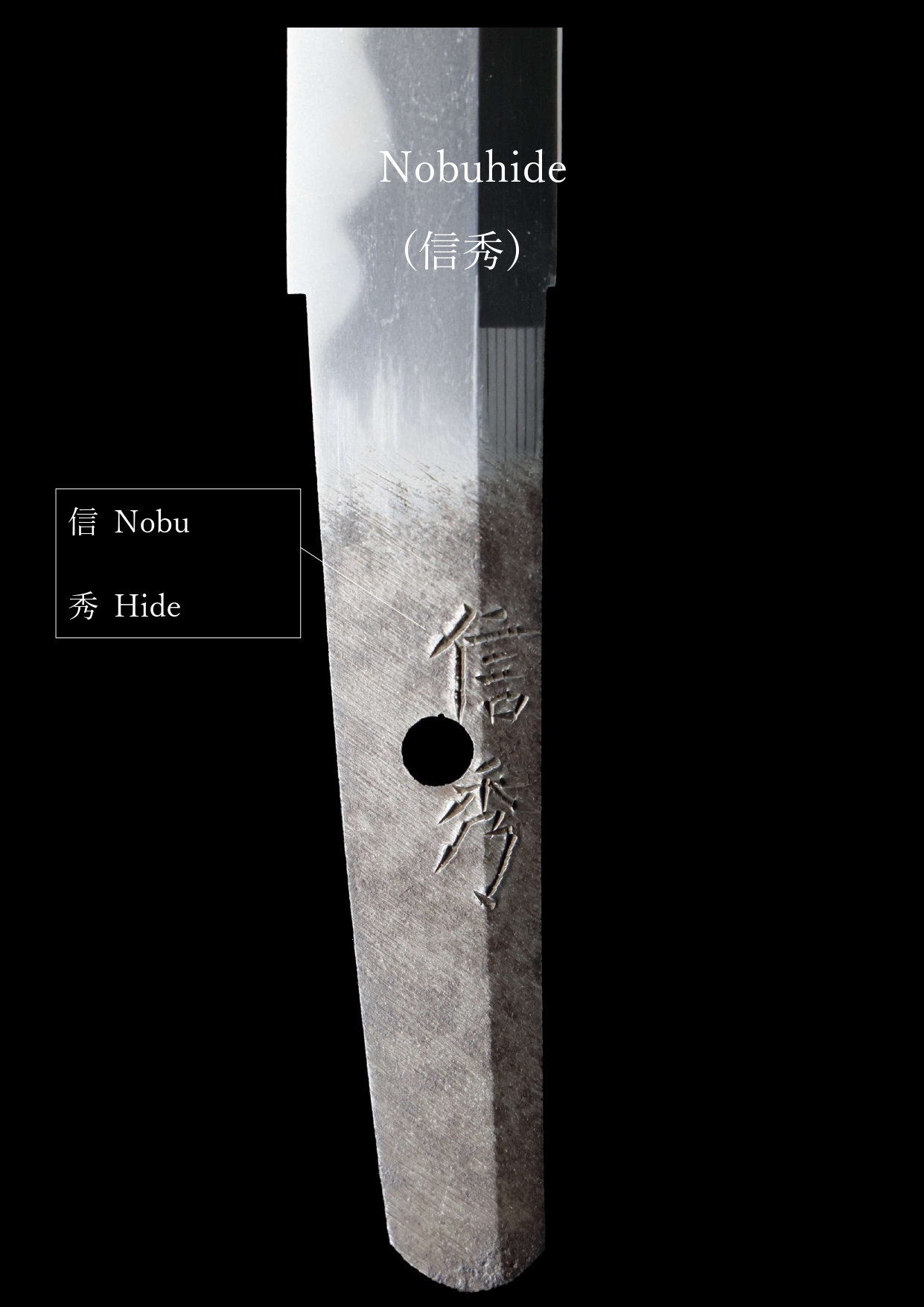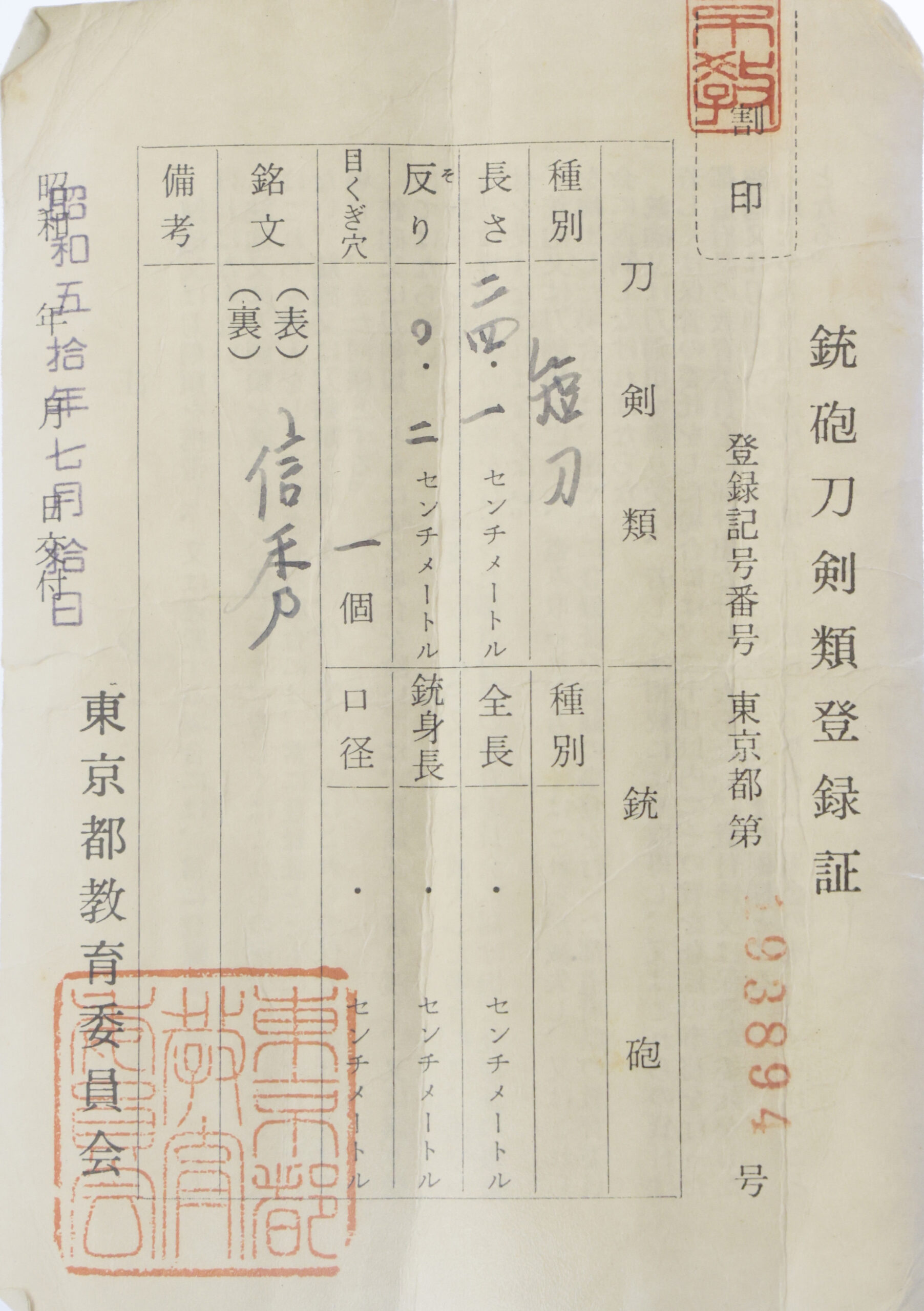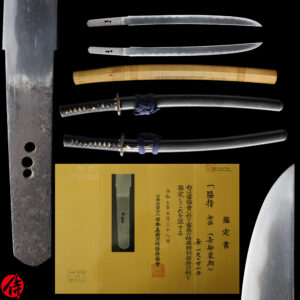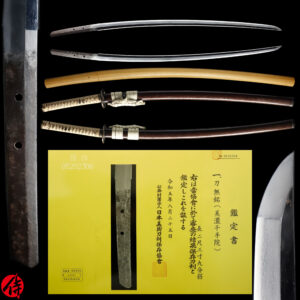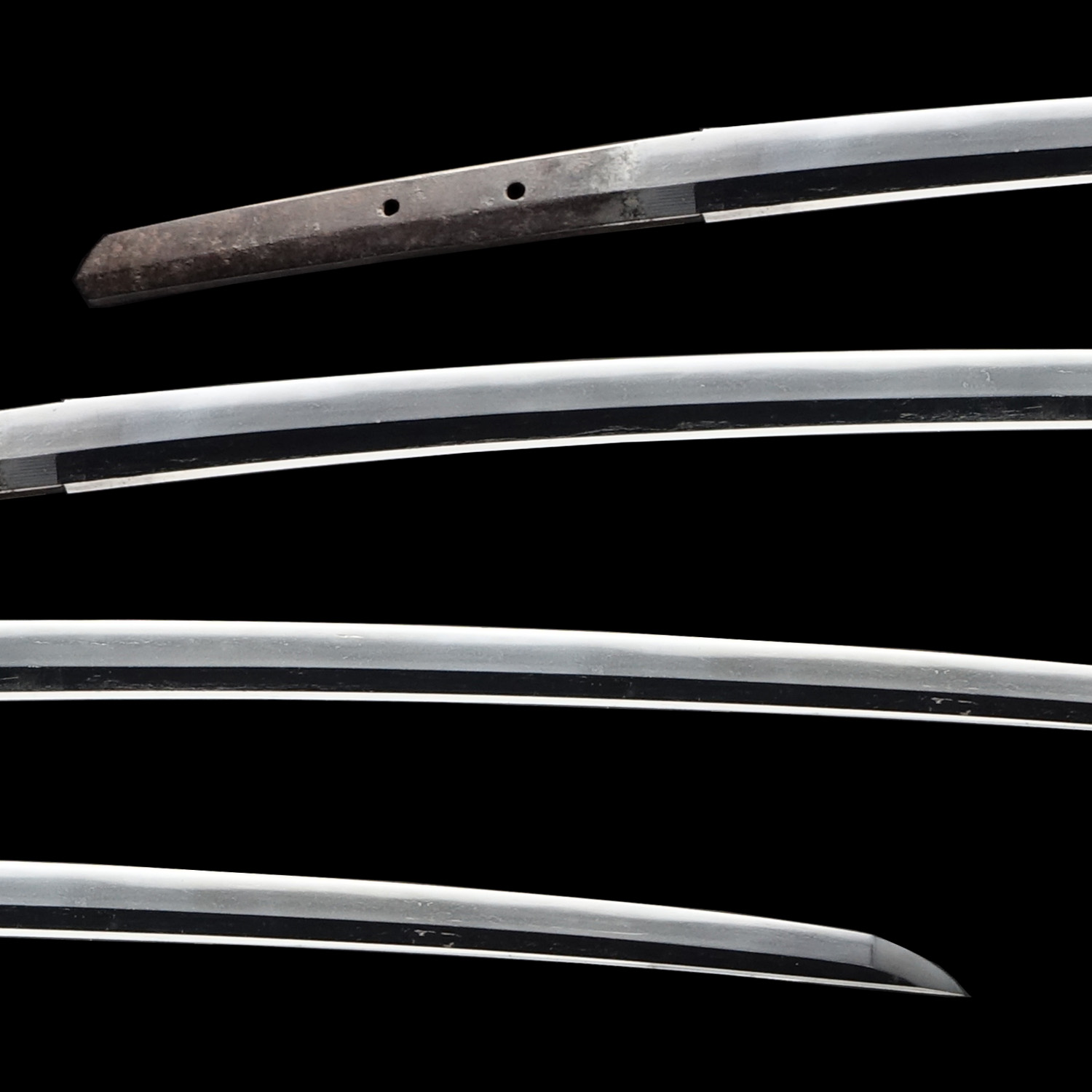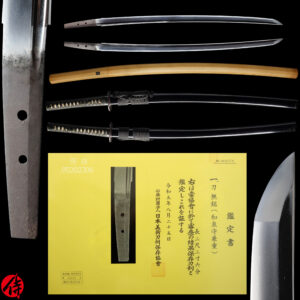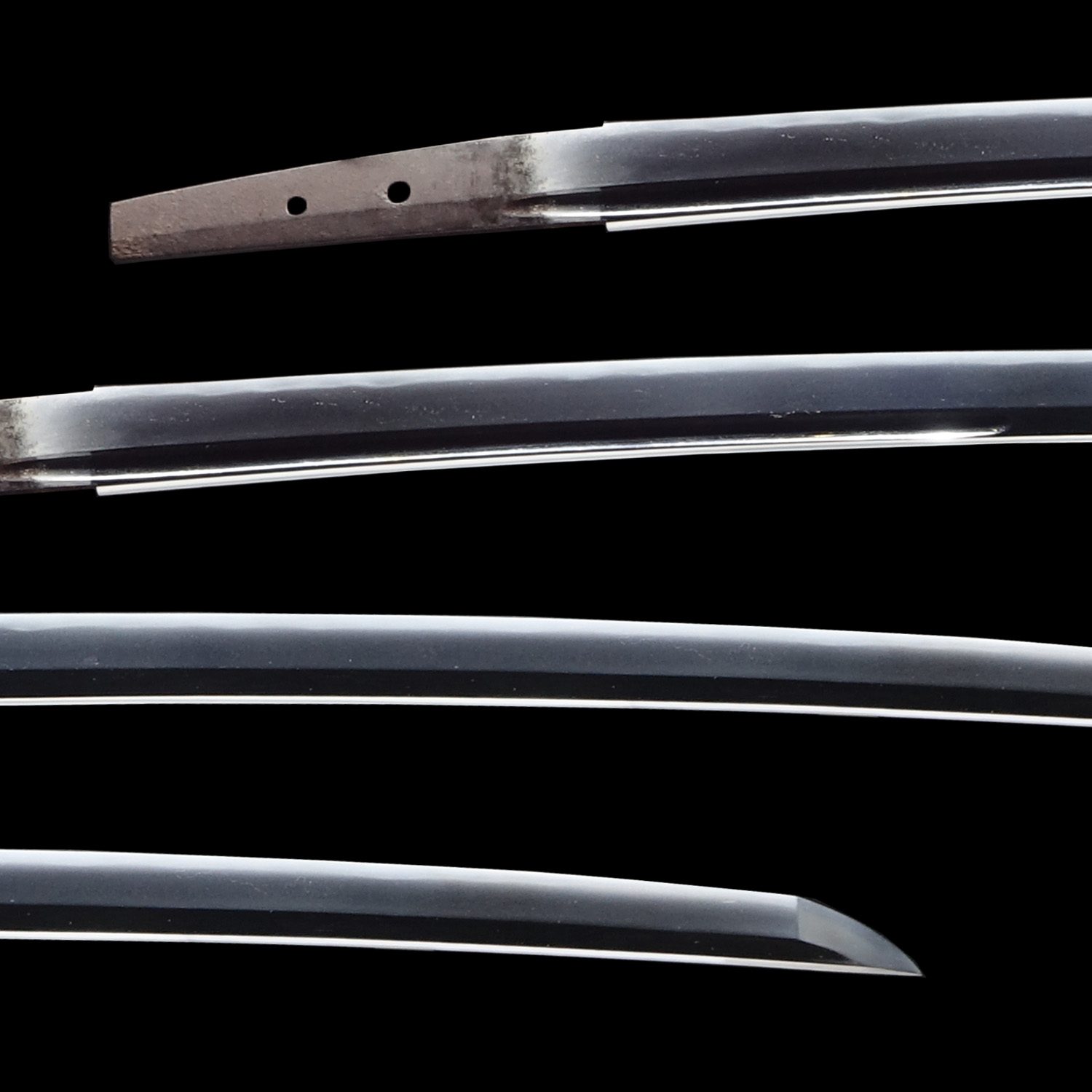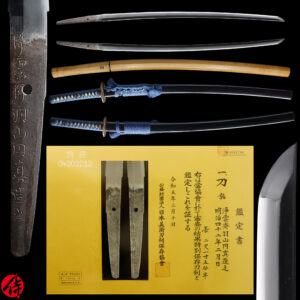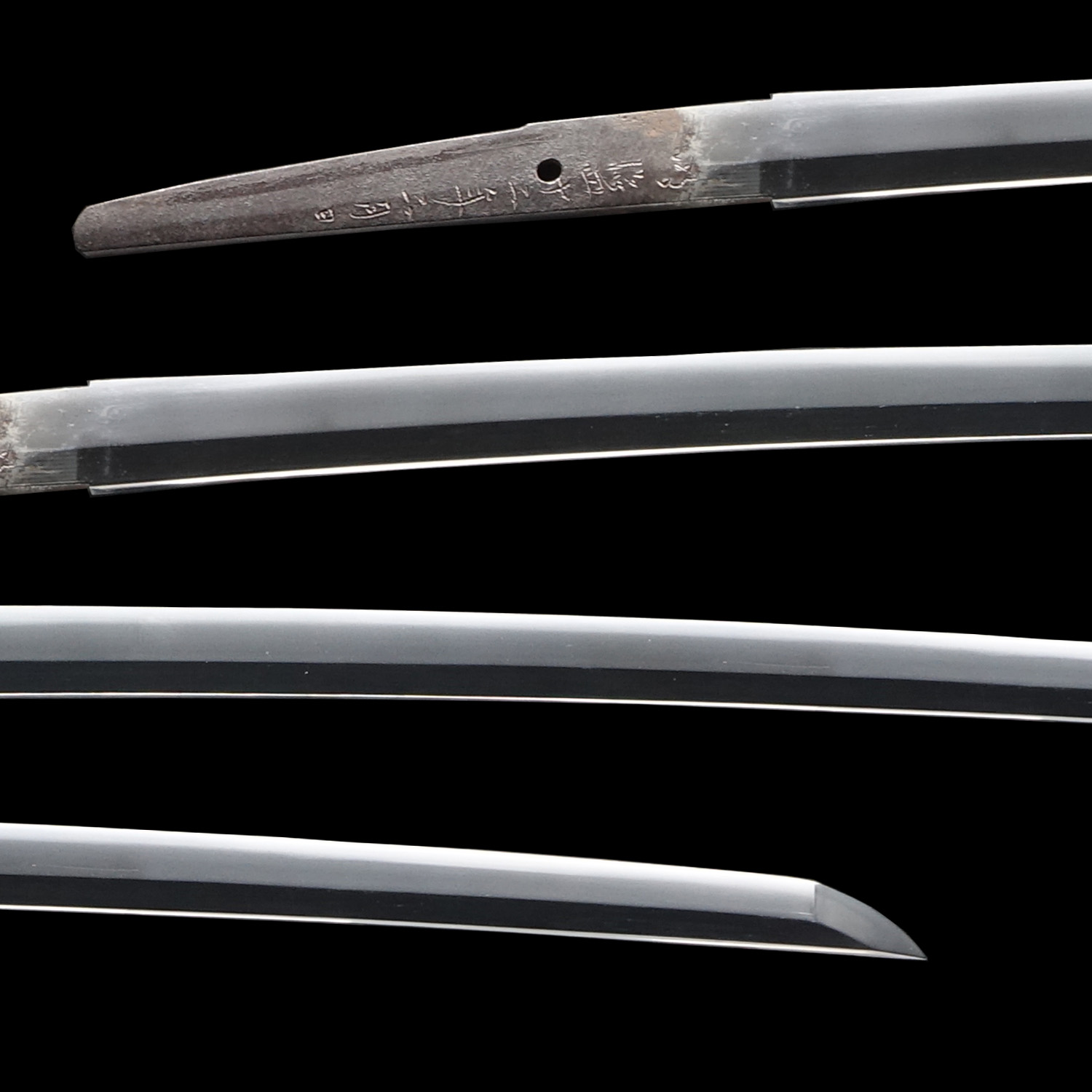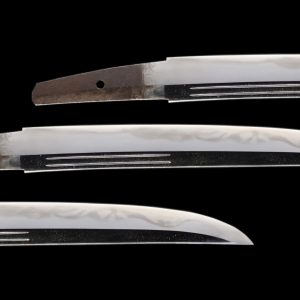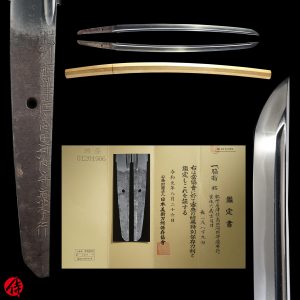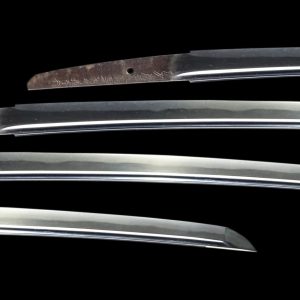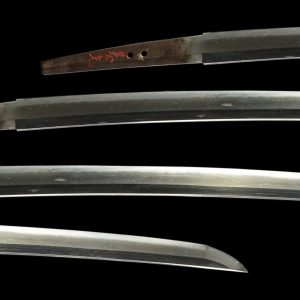Antique Japanese Sword Tanto Signed by Nobuhide with NBTHK Tokubetsu Hozon Certificate
【Description】
Summary
This blade was signed by Nobuhide (信秀). also known as Chikuzen no Kami Nobuhide (筑前守信秀) during the end of the Edo period. He is considered a top-tier swordsmith at the end of the Edo period. Nobuhide was born in Echigo province (today’s Nigata prefecture) in the 12th year of the Bunka era (1815). In the 12th year of the Bunsei era (1829), he moved to Kyoto and became a famous mirror craftsman. Eventually, he relocated to Edo city (today’s Tokyo) to become an apprentice of Kiyomaro in the third year of the Ka-Ei era (1850). Nobuhide was about 34-35 years old when he first studied sword-forging techniques from Kiyamaro, one of the most skilled and renowned swordsmiths at the end of the Edo period. Kiyomaro was just two years older than Nobuhide back then. He was so talented that he mastered superb craftsmanship from Kiyomaro in less than three years. Nobuhide was treated as Kiyomaro’s No.1apprentice.
Nobuhide became an independent swordsmith in the fifth year of the Ka-Ei era (1852). In the first year of the Keio era (1865), he received an honorable official title Chikuzen no Kami (筑前守) from the emperor Komei. According to historical records, he stayed in Sagami province (today’s Kanagawa prefecture) during 1853-1854. And he resided in Osaka between 1864-1867.
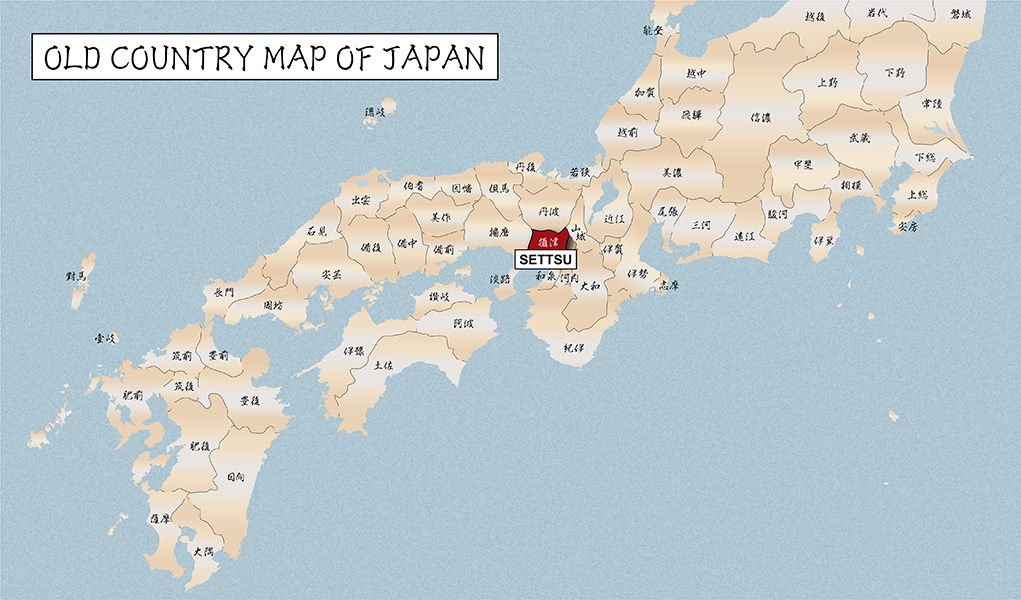

In his early career, he signed Nobuhide (信秀) and then changed it to Kurihara Kenji Nobuhide (栗原謙司信秀). And lastly, he signed Taira Nobuhide (平信秀). Nobuhide was active between 1852-1877 (the 5th year of Ka-Ei~10th year of the Meiji era). He is known as one of the three masters of the sword-forging at the end of the Edo period. The other two are Gassan Sadakazu and Honjo Yoshitane. Nobuhide is considered one of the top-tier swordsmiths among Japanese sword experts and collectors.
Even after the Samurai era ended in 1868, Nobuhide kept forging swords. And in the second year of the Meiji era (1869: post Samurai era), he was requested by the emperor Meiji to forge a ceremonial sword, which was considered one of the highest honors for any swordsmiths.
The Meiji government also ordered him to create three divine mirrors and a holy blade for a newly built shrine called Shokonsha (today’s Yasukuni shrine).
Shokonsha was built to honor the spirits of those who died during the civil war at the end of the Edo period. This fact suggests that Nobuhide was one of Japan’s most respected and acknowledged swordsmiths. He finished this project in the 7th year of the Meiji era (1874). And, he came back to Echigo province and restarted making mirrors for shrines. He died at the of 66 in his house in Tokyo.
What is Tanto?
Japanese swords under the blade length of 30cm (11.6 inches) are generally called TANTO, and sometimes TSUBA(鍔; Hand-Guard) is not attached to the TANTO. It was easy to carry and convenient for close combats. It was initially used as a supplemental weapon for Samurai on horseback, who used a pole weapon or long sword in the Kamaura-Muromachi period. Samurai aimed at an unprotected area of his enemy’s armor with Tanto while having to fight with close distance.
TANTO was named accordingly, depending on how you carry it, such as HUTOKORO-GATANA (懐刀; Stomach-Sword) or KOSHI-GATANA(腰刀; Waist-Sword) or elsewise. TANTO was also a gift for a bride from her family in a traditional Japanese wedding, as it is believed that TANTO would be divine protection from evil power.
This blade is appraised as a Hozon Touken (保存刀剣) issued by NBTHK (Nihon Bijutsu Touken Hozon Kyokai: 日本美術刀剣保存協会). This authentication paper was only given to authentic Japanese swords, well preserved and high quality with artistic value.
【Blade】
Cutting Edge Length (Nagasa): 24.1 cm (9.05 inches)
Curvature (Sori): 0.2 cm ( 0.07 inches)

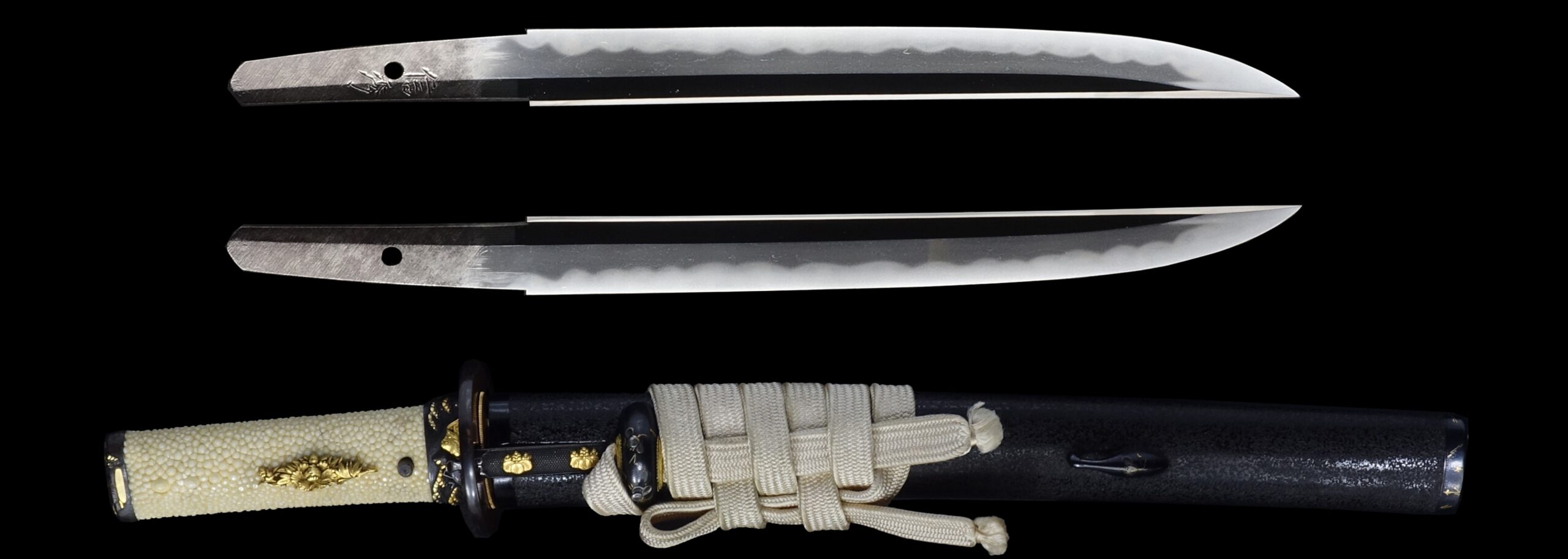
Hamon:
The crystalline structure which forms along the cutting edge of a blade as a result of the hardening process.
Jimon (Jihada):
Visible steel surface pattern created by folding and hammering during forging process.
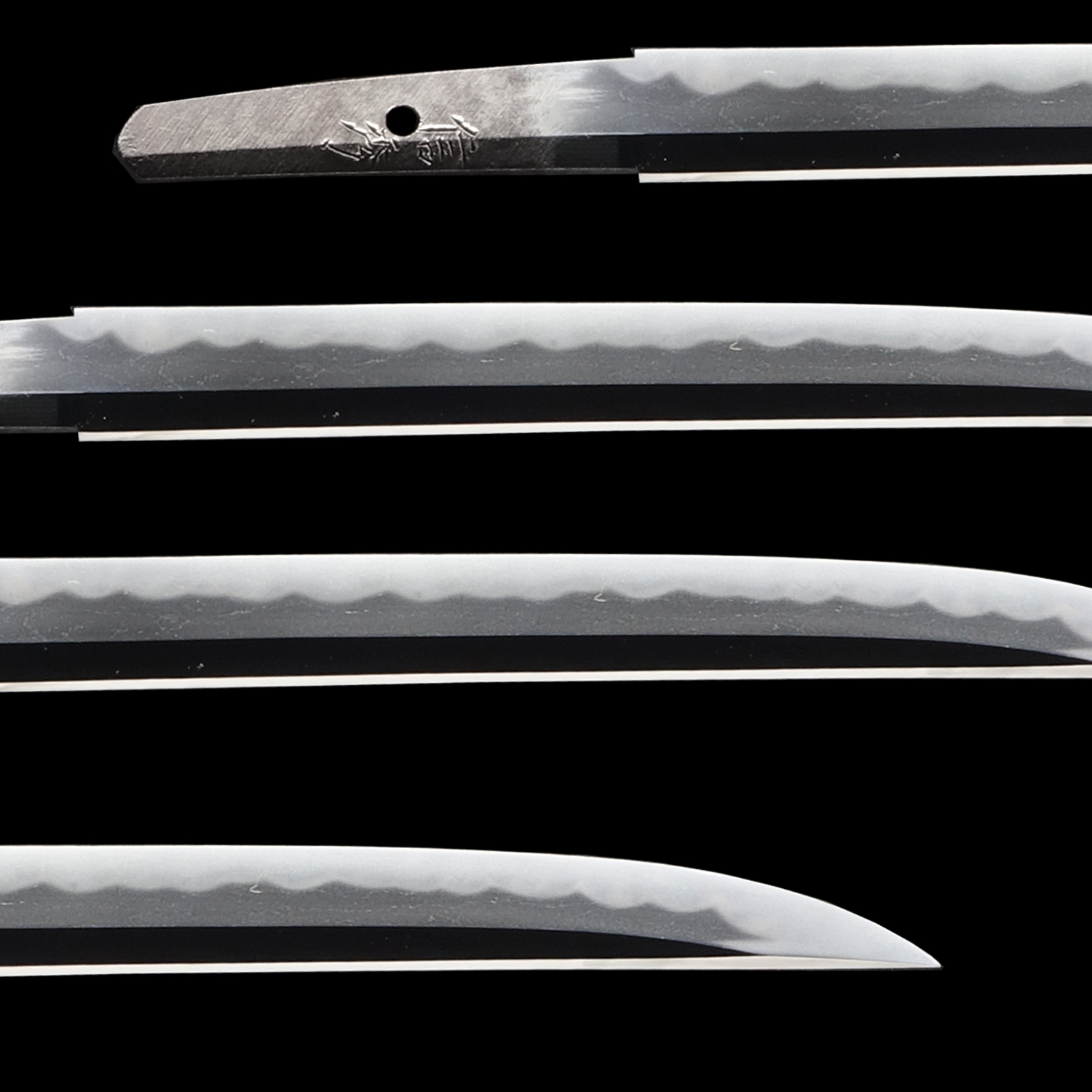
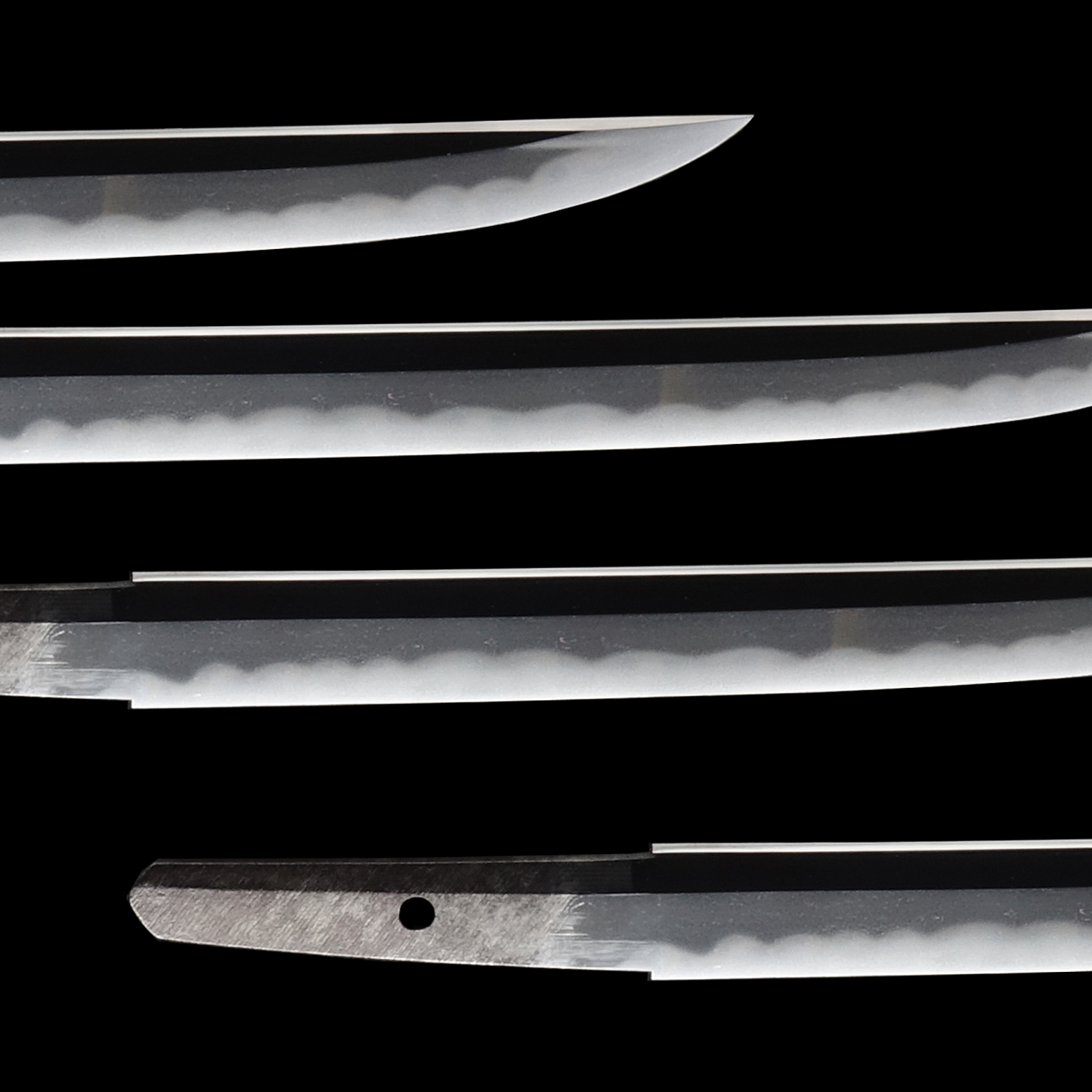
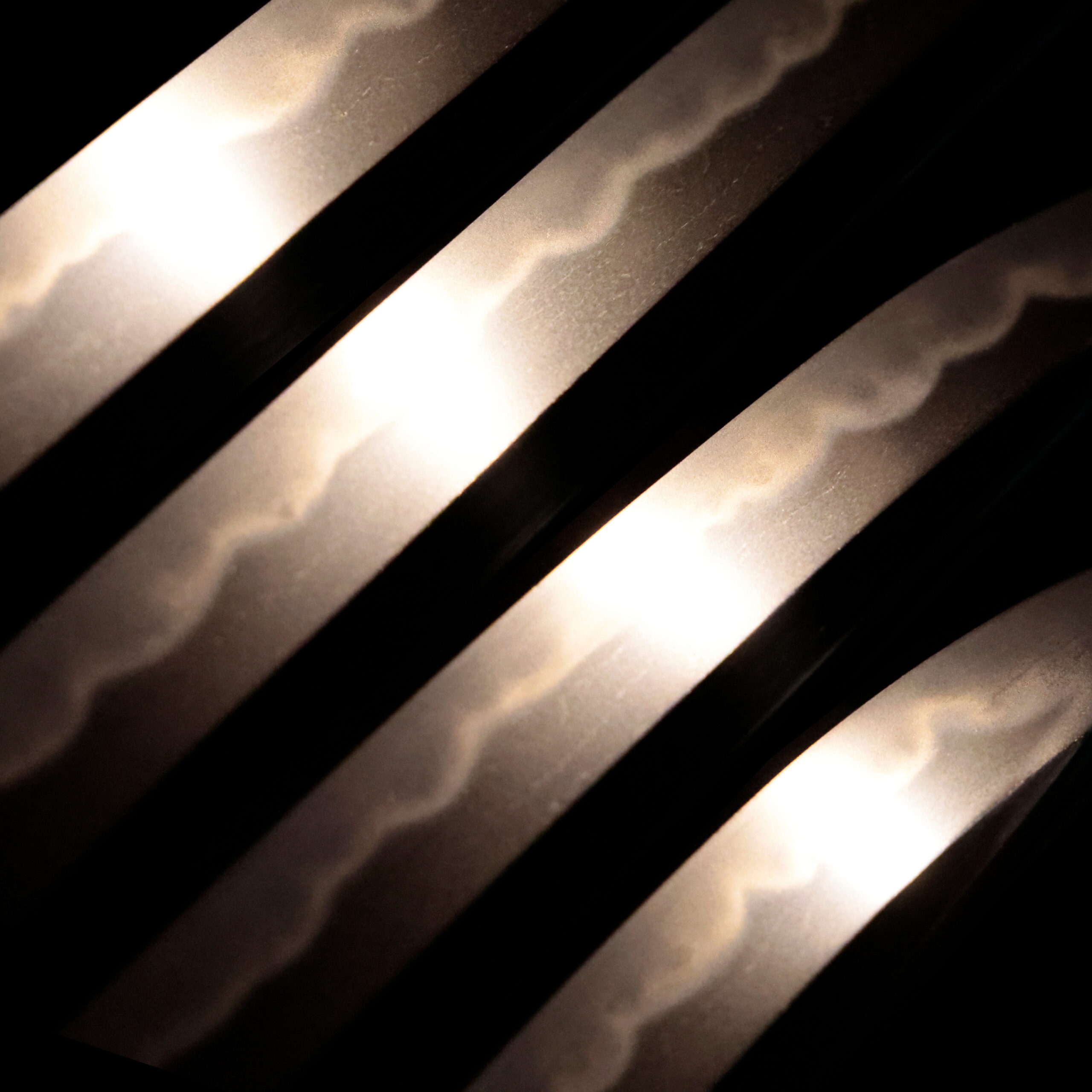
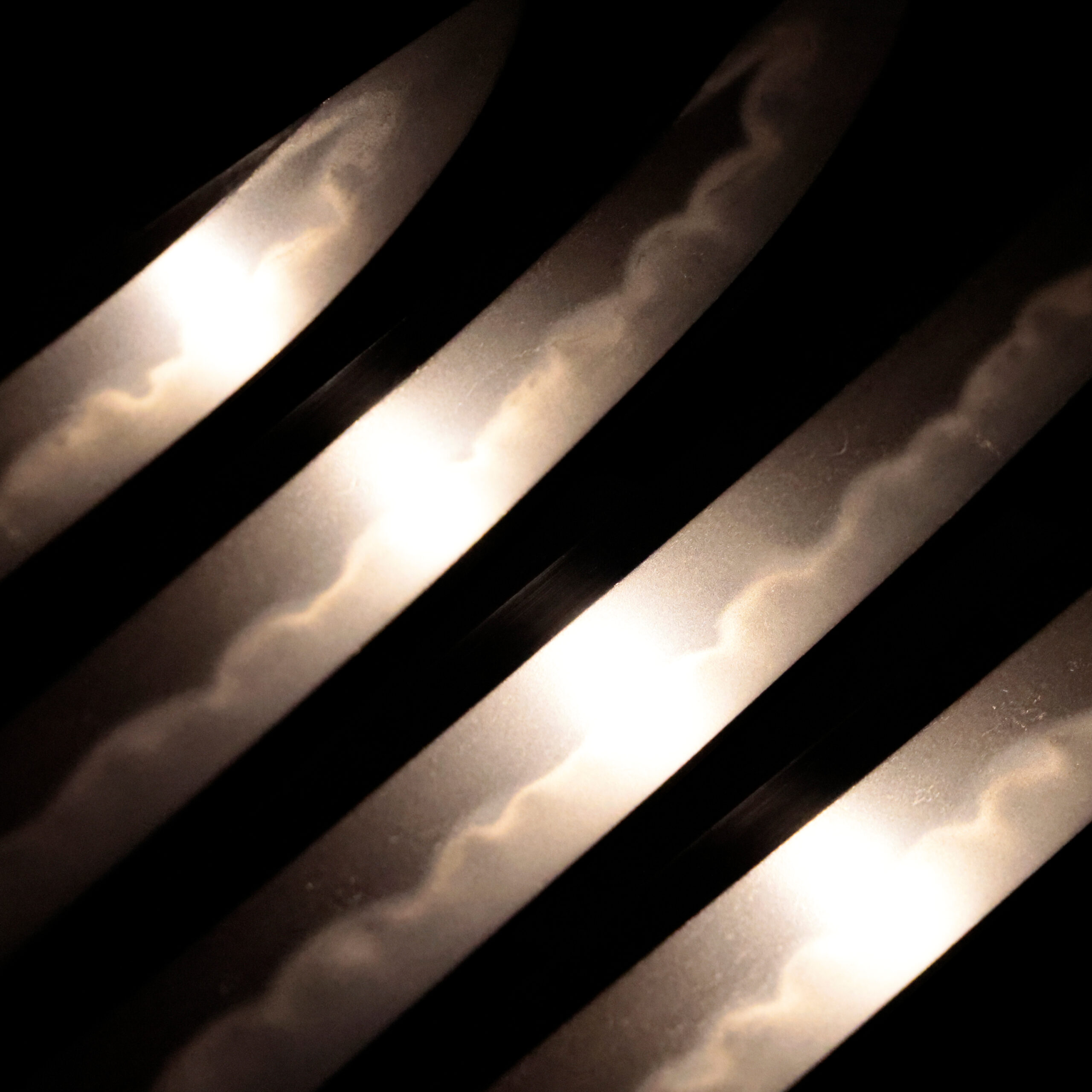

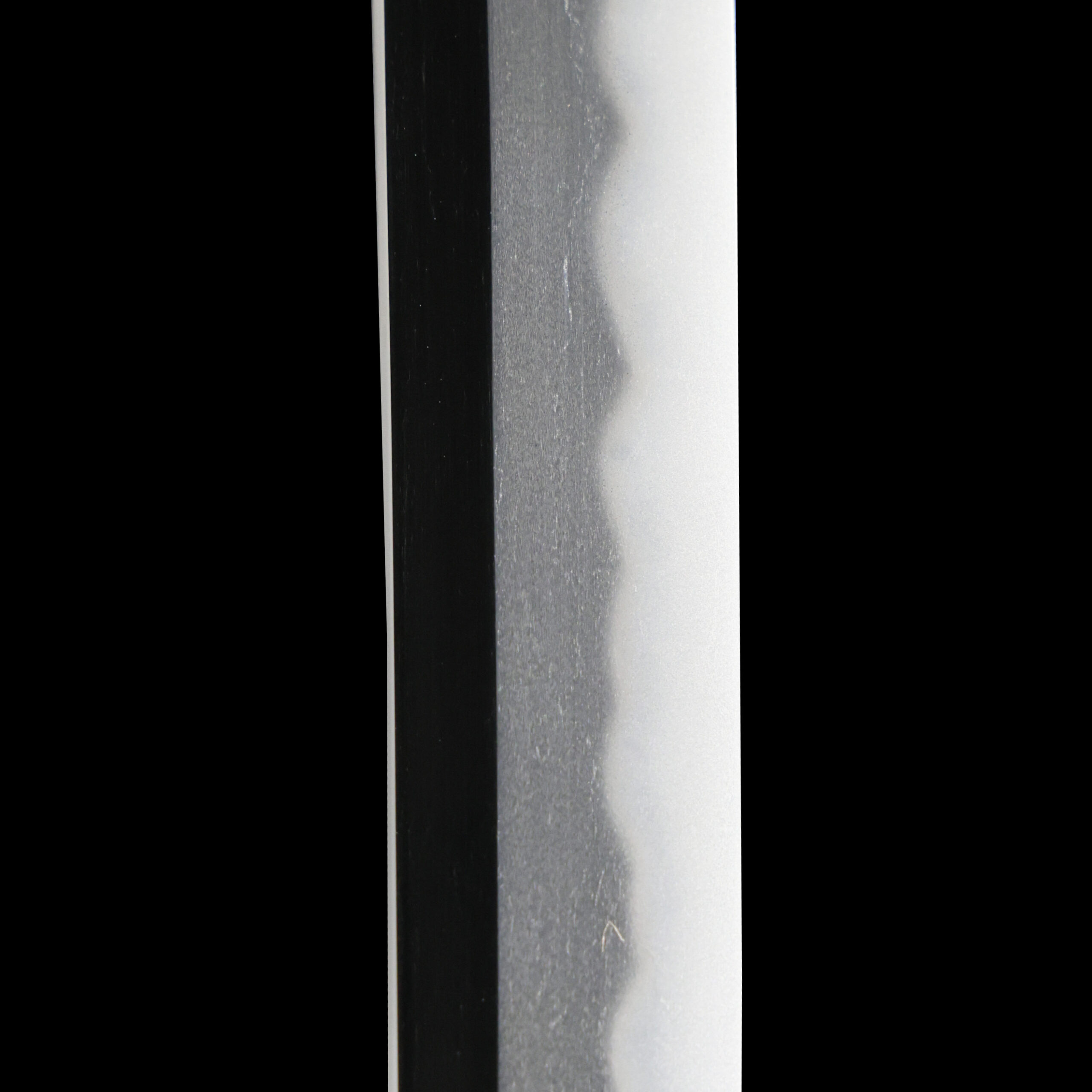
Kissaki: Kissaki is the tip of the Japanese sword.
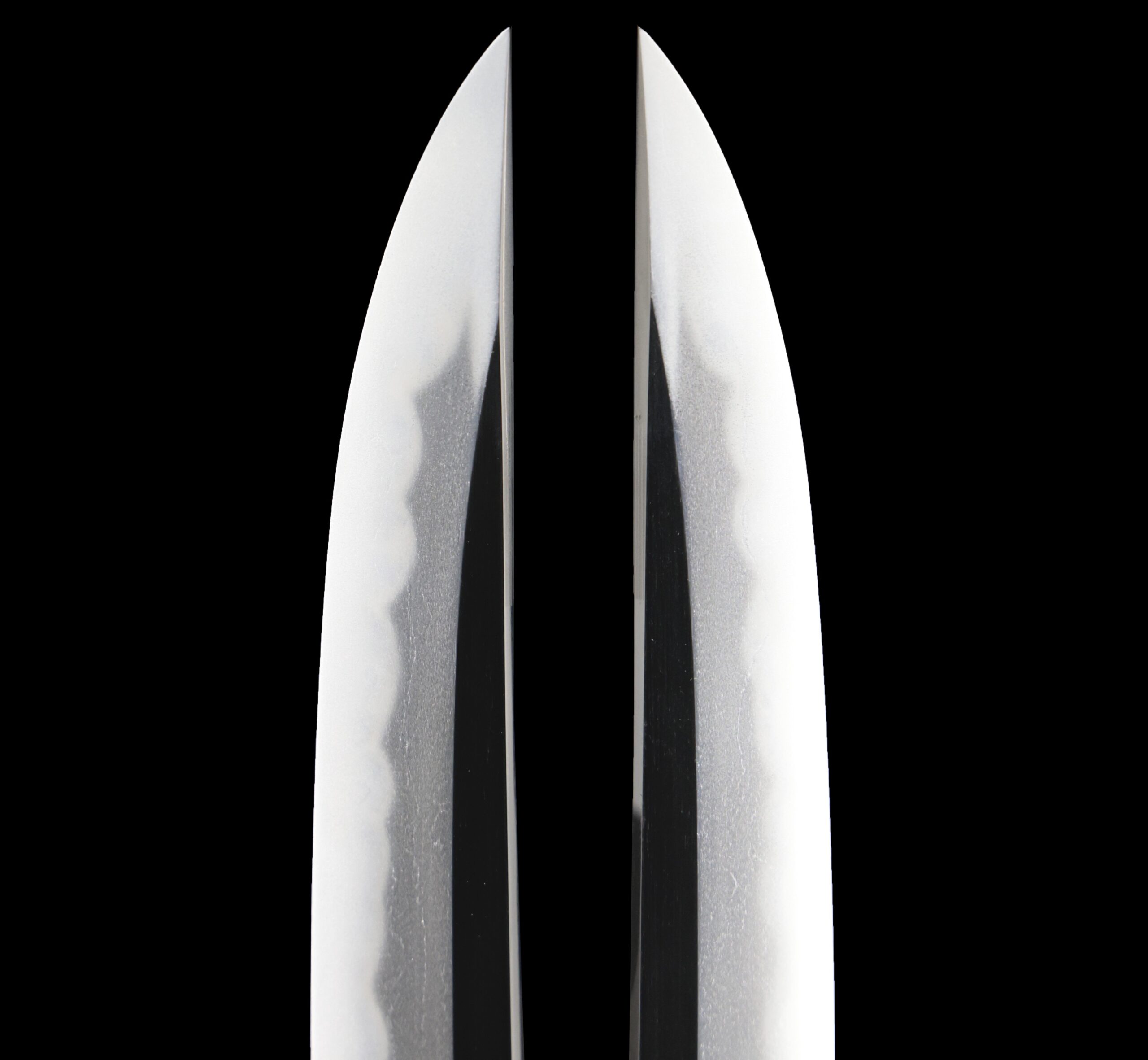
Nakago: Nakago is the tang of the Japanese sword.
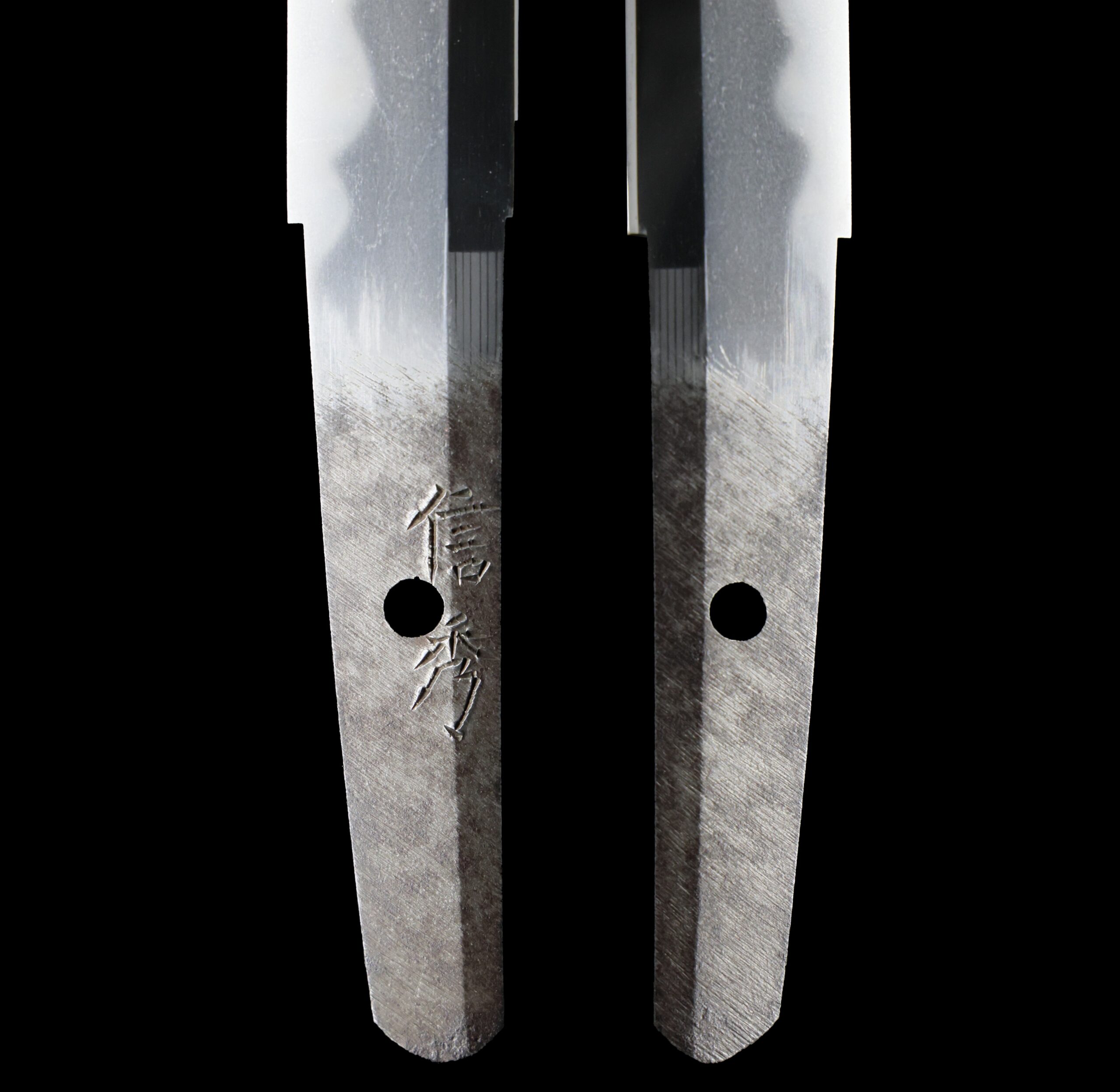
Koshirae: Koshirae is the mounting of the Japanese sword. There are several parts that consist of Koshirae such as Saya (Scabbard), Tsuka (Handle), Tsuba (Handguard).
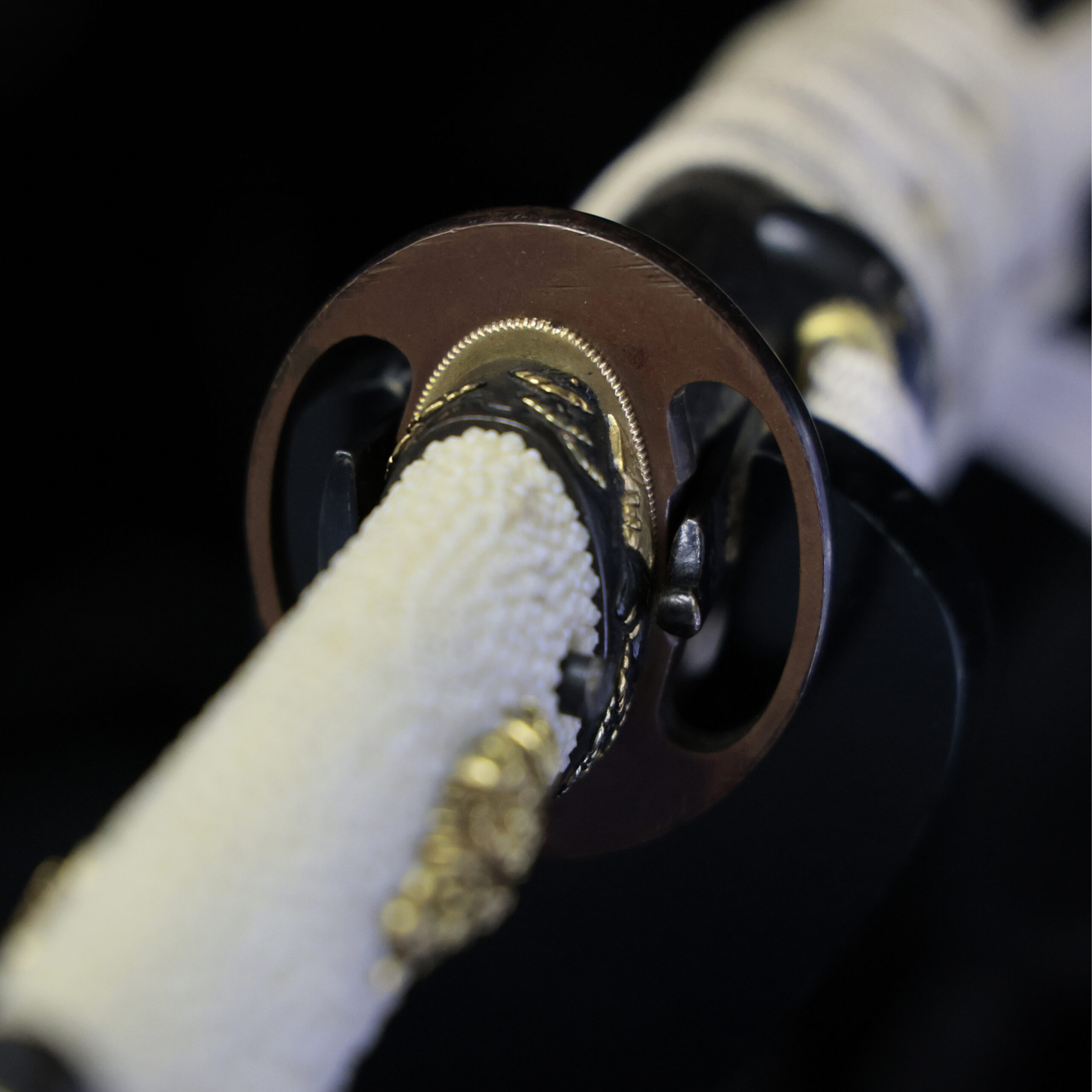
Fuchi-Kashira: A pair of matching sword fittings that cover the upper and bottom parts of its sword hilt.
The motif of this Fuchi-Kashira is pine tree (松, matsu). As pine trees keep their green color throughout the years by withstanding severe heat and cold, people thought this plant pattern represents eternal youth. Furthermore, its color is called Tokiwa-Iro (常盤色, evergreen trees’ dark green color with brown), and pine trees have another name “Tokiwa-Gi (常盤木).” Tokiwa means immutability, so Tokiwa-Iro is a color that praises green with a wish for longevity and prosperity. It is said this color was appreciated, especially in the Edo period, as a good-luck color. The pine tree design gives us an elegant and noble impression; it might be another reason that people love this motif.
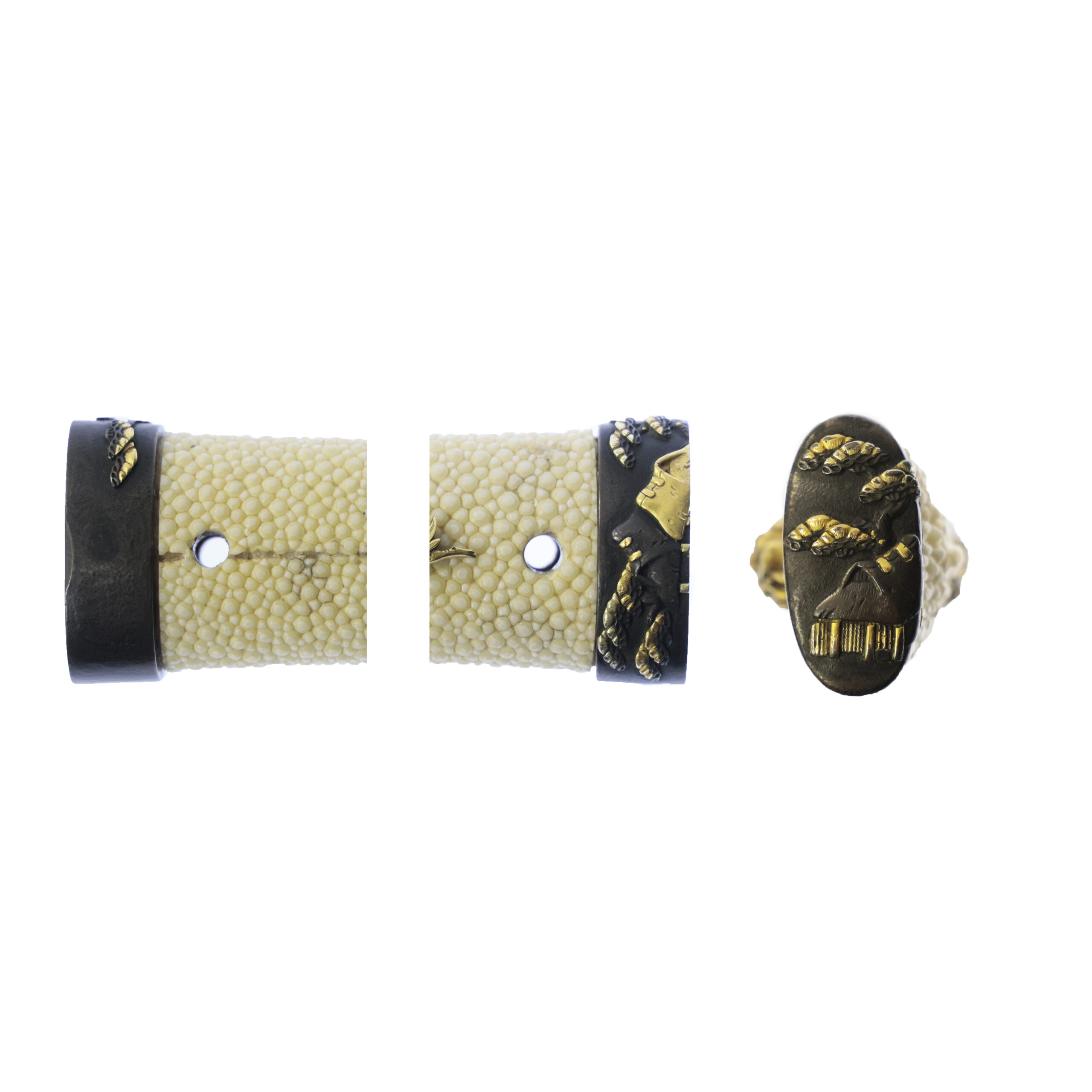
Tsuka and Menuki: Tsuka is the handle of the Japanese sword and Menuki is its decoration.
The theme of this Menuki is peony (牡丹, botan). Peony represents happiness, wealth, nobleness, and gorgeousness. This flower pattern has been treated as a kind of good-omen motif; people regarded it as a rich harvest sign. Peony is called “Botan” in Japanese. When we write this flower’s name in Japanese, its second letter means mountain hermit medicine that would give us eternal youth. Based on the meaning of this letter, the peony pattern symbolizes eternal youth and longevity.
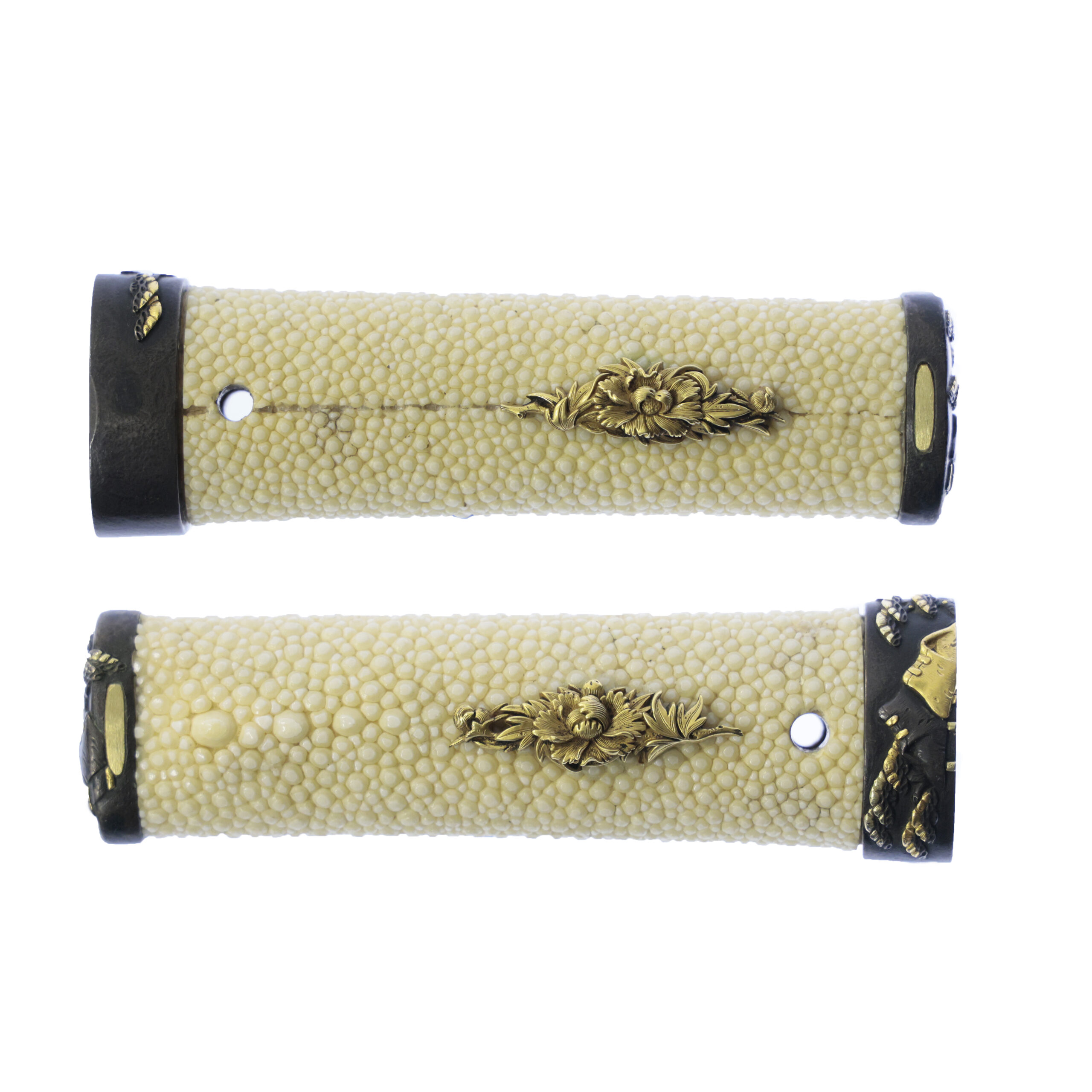
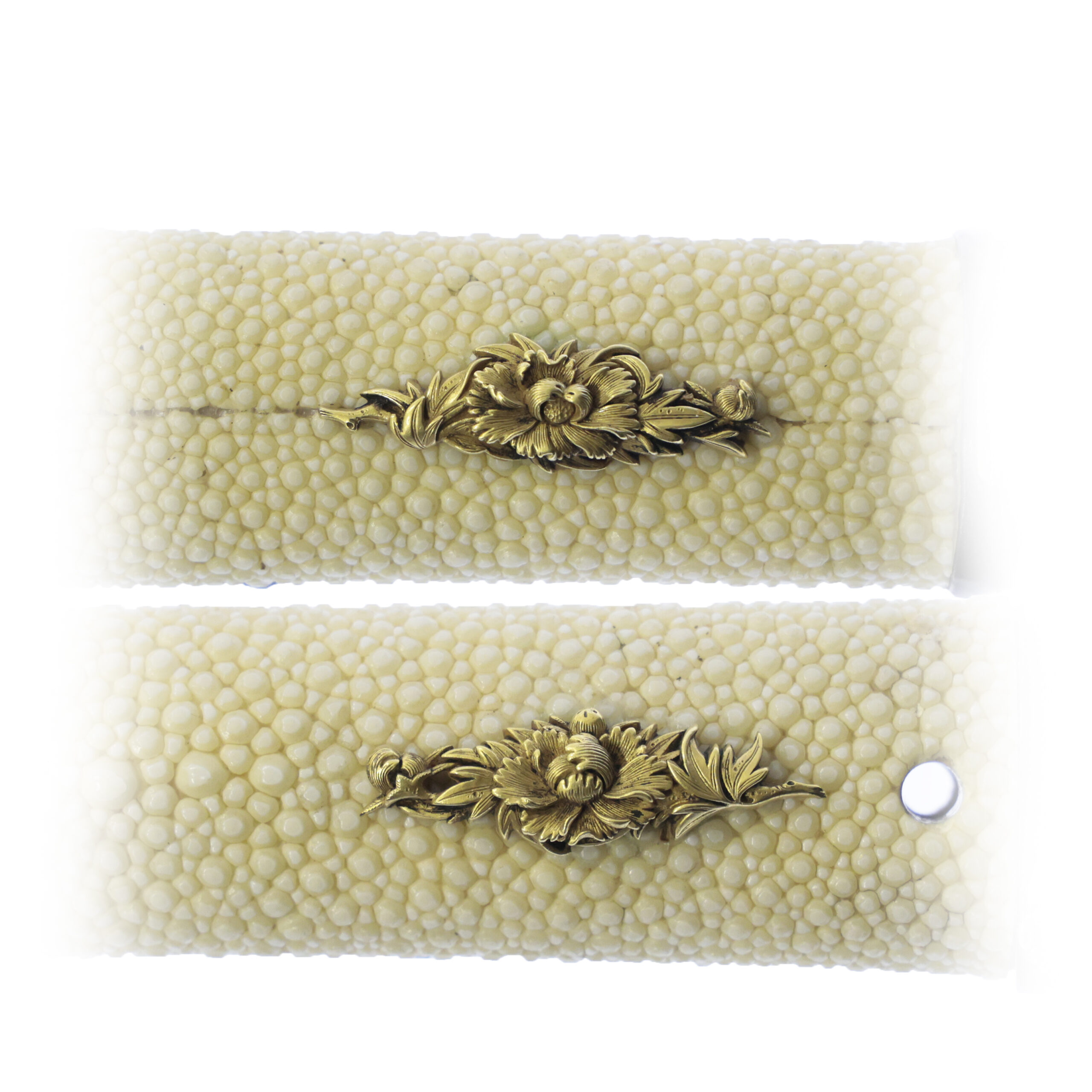
Tsuba and Habaki:Tsuba is the handguard for the Japanese Sword and Habaki is the equipment to make the blade not touch its scabbard inside. It prevents the blade from getting rusty and chipped.
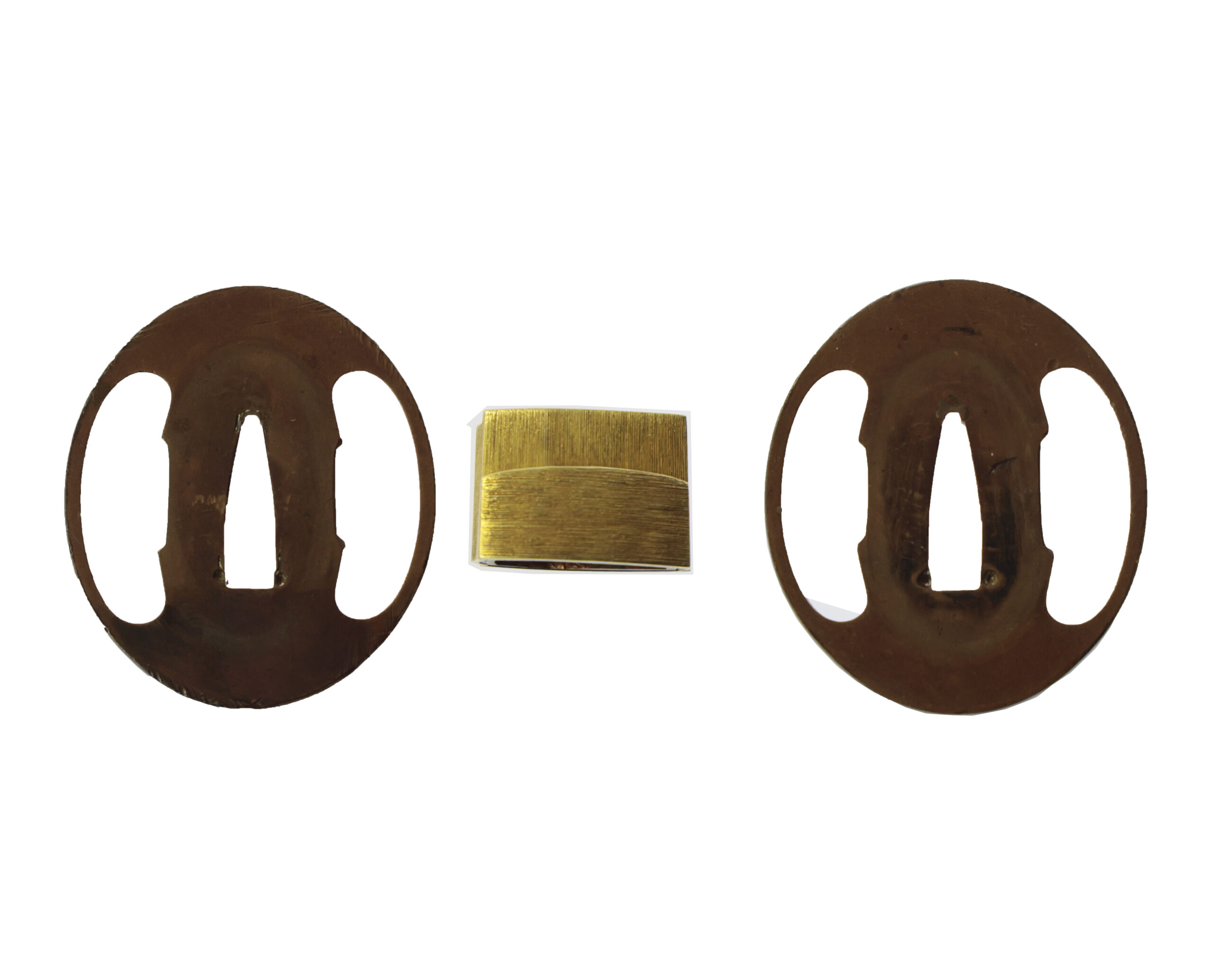
Kozuka: Kozuka is a small knife stored in Kozuka Hitsu(groove of the sheath of the Japanese sword).
The motif of this Kozuka is Gosan-no-Kiri Monyou (五三の桐文様). It is a popular design that the paulownia motif is used. This pattern was once used by the imperial family and people in authority at that time. Today, it is permitted to use by ordinary households and is appreciated as their family crests. According to a tradition, Houou (鳳凰, Fenghuang, a kind of sacred beast) rests its wings at the paulownia tree; therefore, it has come to be regarded as a holy plant.
The Kiri (桐) pattern is generally composed of three standing straight inflorescences and three leaves. The number of flowers that are blooming at each inflorescence means the ranks of this design. It is also famous that one of the most popular Samurais in Japan: Toyotomi Hideyoshi used the Kiri pattern for his family crest. According to a theory, Hideyoshi used Omodaka (沢瀉, arrowhead) pattern as his family crest. However, Oda Nobunaga, a well-known military commander in the Warring States period, permitted Hideyoshi to use Kiri design. This plant pattern was once used by the imperial family and national leaders of the time. Today, this plant pattern is used as the crest of the Japanese Government.
*This Kozuka has a wooden knife. If you like to have a metal knife for it, please contact us.
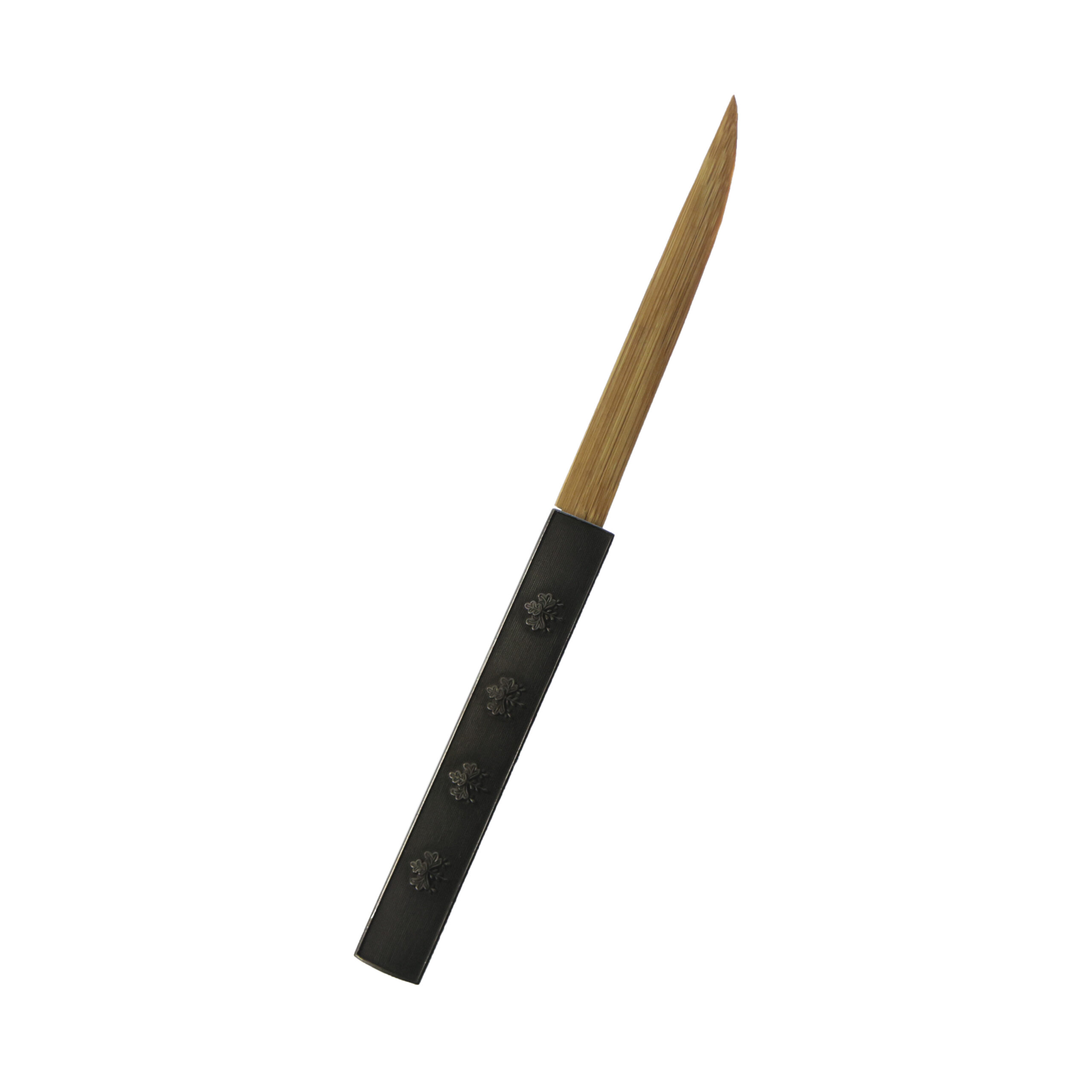
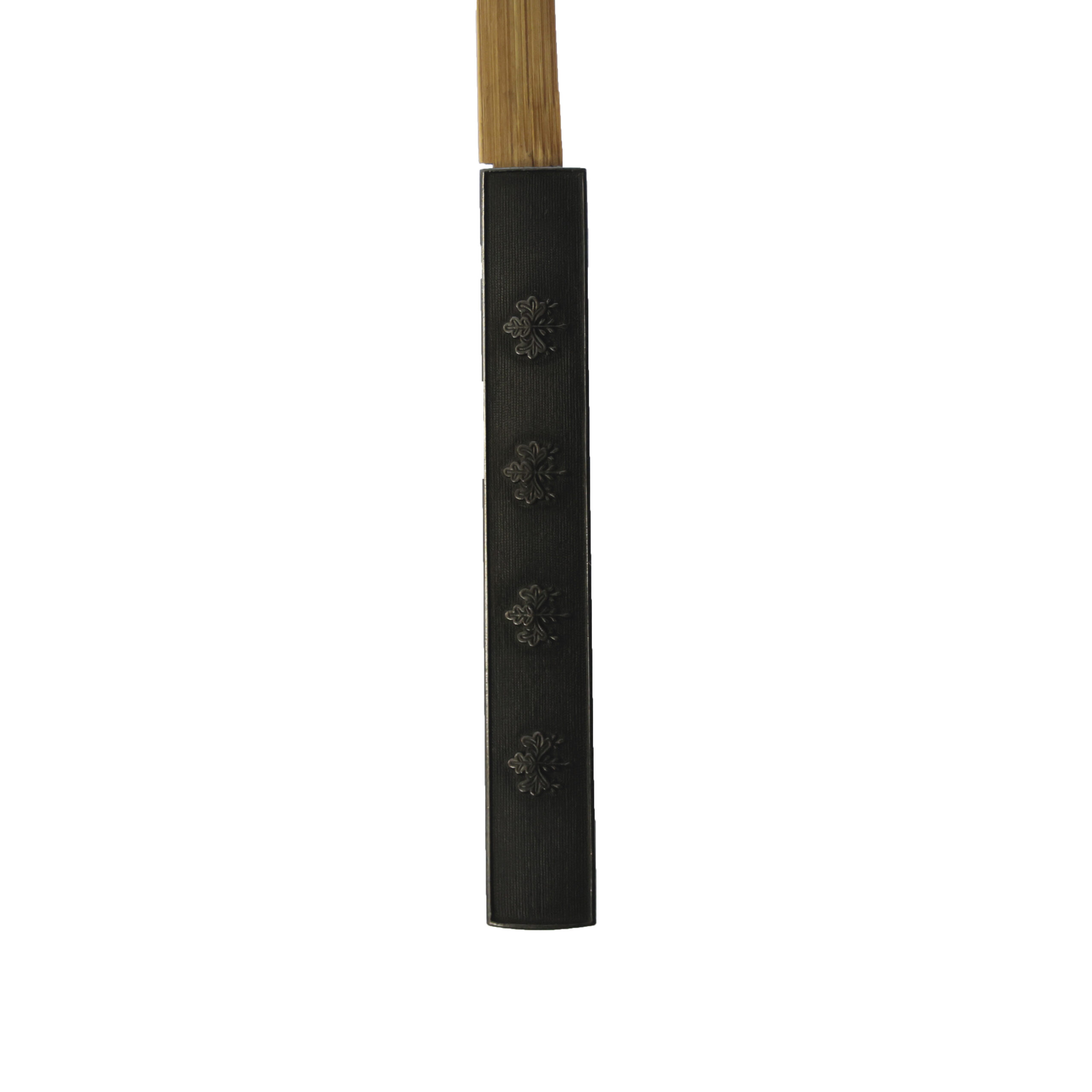
*In the photos, a wooden blade is fitted inside. However, when we ship it, the metal blade will be included.
Kougai:Kougai is the equipment for Samurai to arrange or fix his hair style.
The theme of this Kougai is the same as Kozuka: Gosan-no-Kiri Monyou (五三の桐文様).
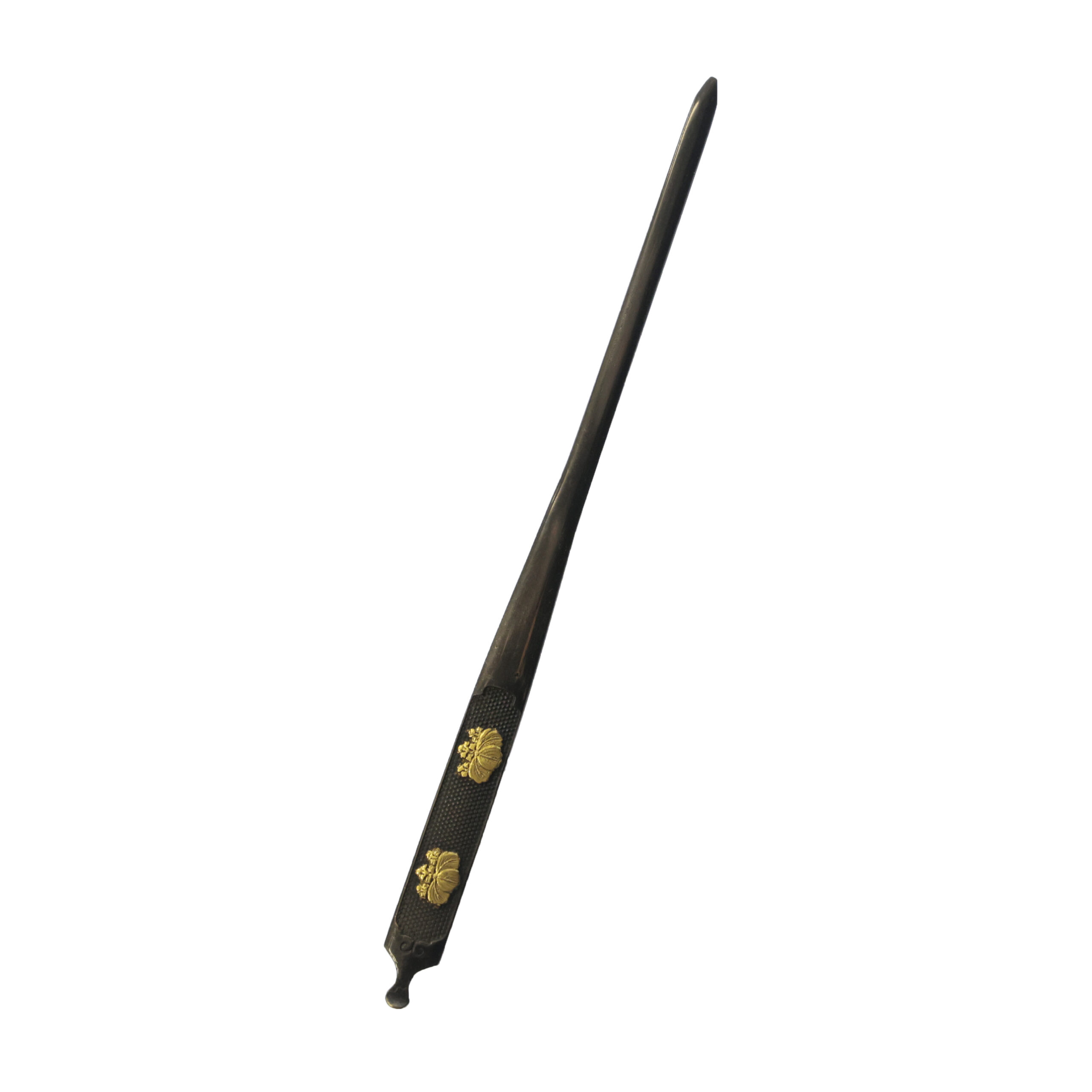
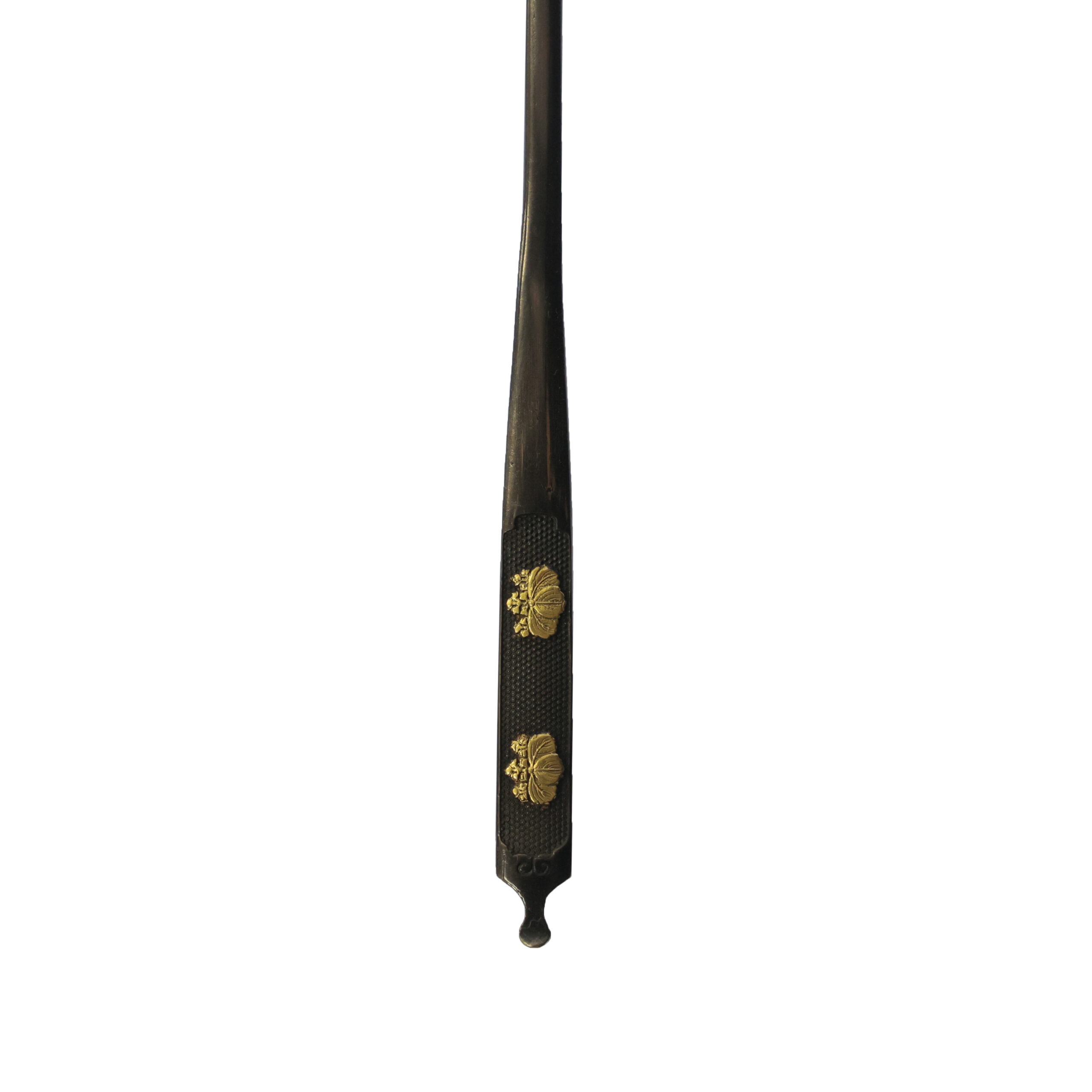
Saya: Saya is the scabbard for the Japanese sword
This saya is finished using the traditional Japanese lacquer technique known as kuro-ishime sendan-kizami nuri (黒石目千段刻塗). The ishime-nuri (stone-texture lacquer) creates a black, textured surface that resembles natural stone. This technique not only enhances the visual appeal but also provides a non-slip grip and excellent durability, making it both beautiful and practical.
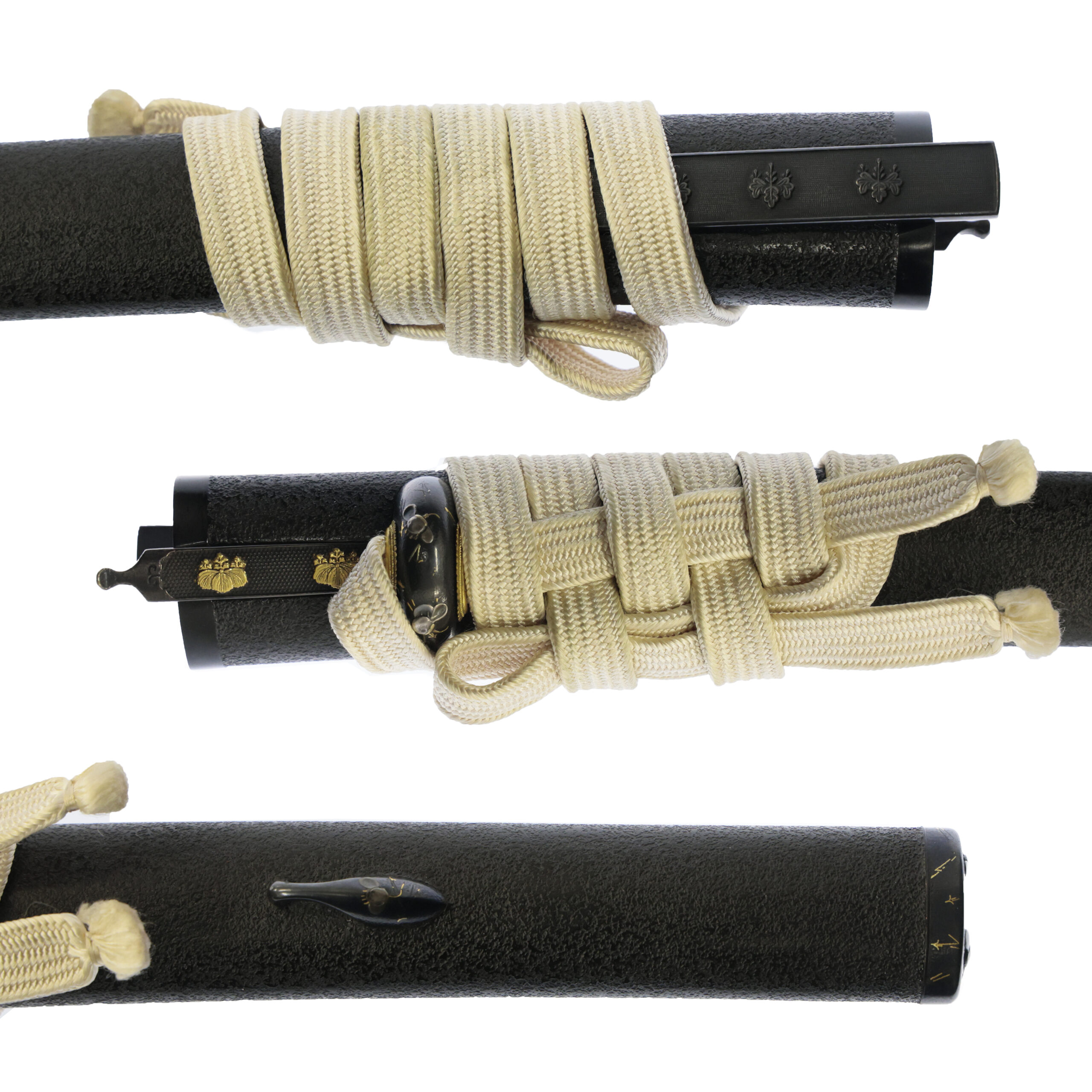
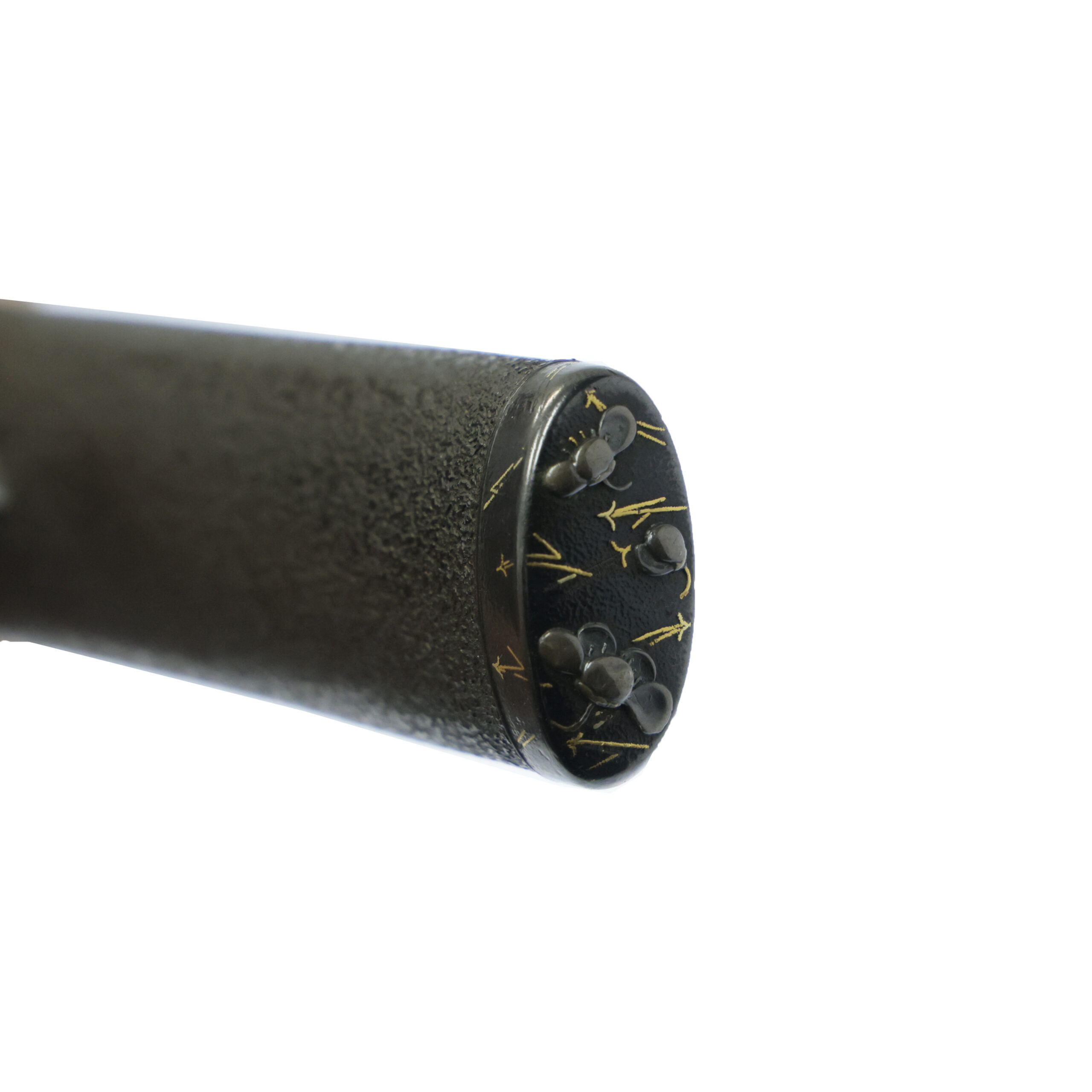
Authentificathentication Paper:NBTHK Tokubetsu Hozon Certificate for the blade (No. 140338 )
NBTHK, also known as Nihon Bijutsu Touken Hozon Kyokai (the Society for the Preservation of the Japan Art Sword), is one of the oldest Japanese sword appraising organizations in modern-day Japan. They authenticated the blade on April 14th in the 7th year of Heisei (1995). They appraised it as Tokubetsu Hozon Touken, the blade especially worth preserving for Japanese society. The purchaser will receive these original certificates as well. We can also translate what is written into English and make a PDF file for your record if you request.
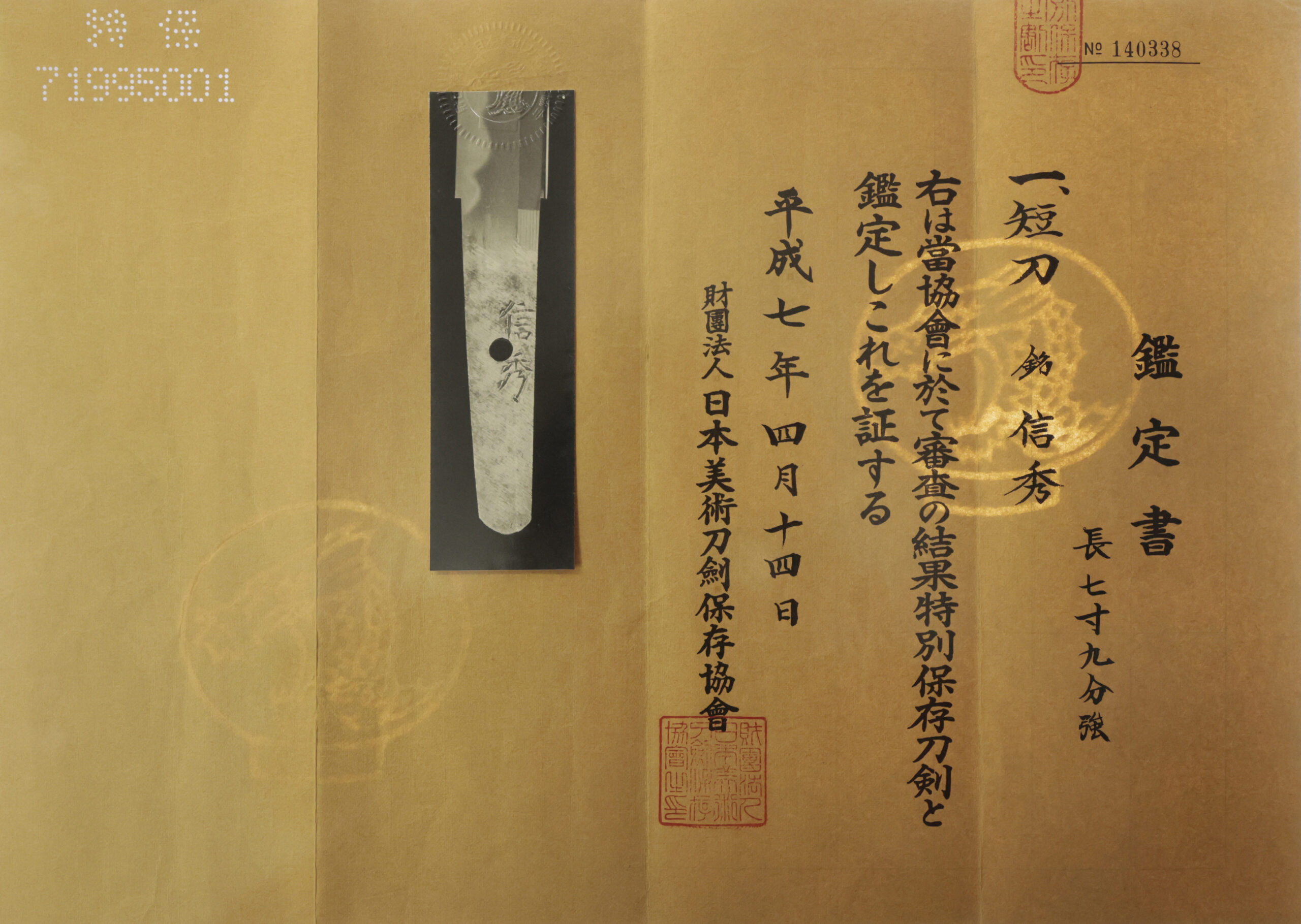
Registration Number : Tokyo 193894
The Board of Education in Tokyo issued a registration paper for this sword . It is called Jyu Token Rui Torokusho(銃刀剣類登録証). Bunkacho(The Agency for Cultural Affairs) acknowledges a Japanese sword with this paper as a work of art.
The sword needs to be traditionally hand-forged and made of Tamahagane carbon steel to be registered in the system. With this paper, its owner in Japan can legally own an authentic Japanese sword. Based on this registration number, we will apply for its export permit.
This paper will need to be returned to the board of education when the sword is being shipped abroad, but you can receive a copy of it. An English translation of this registration paper is available on request.

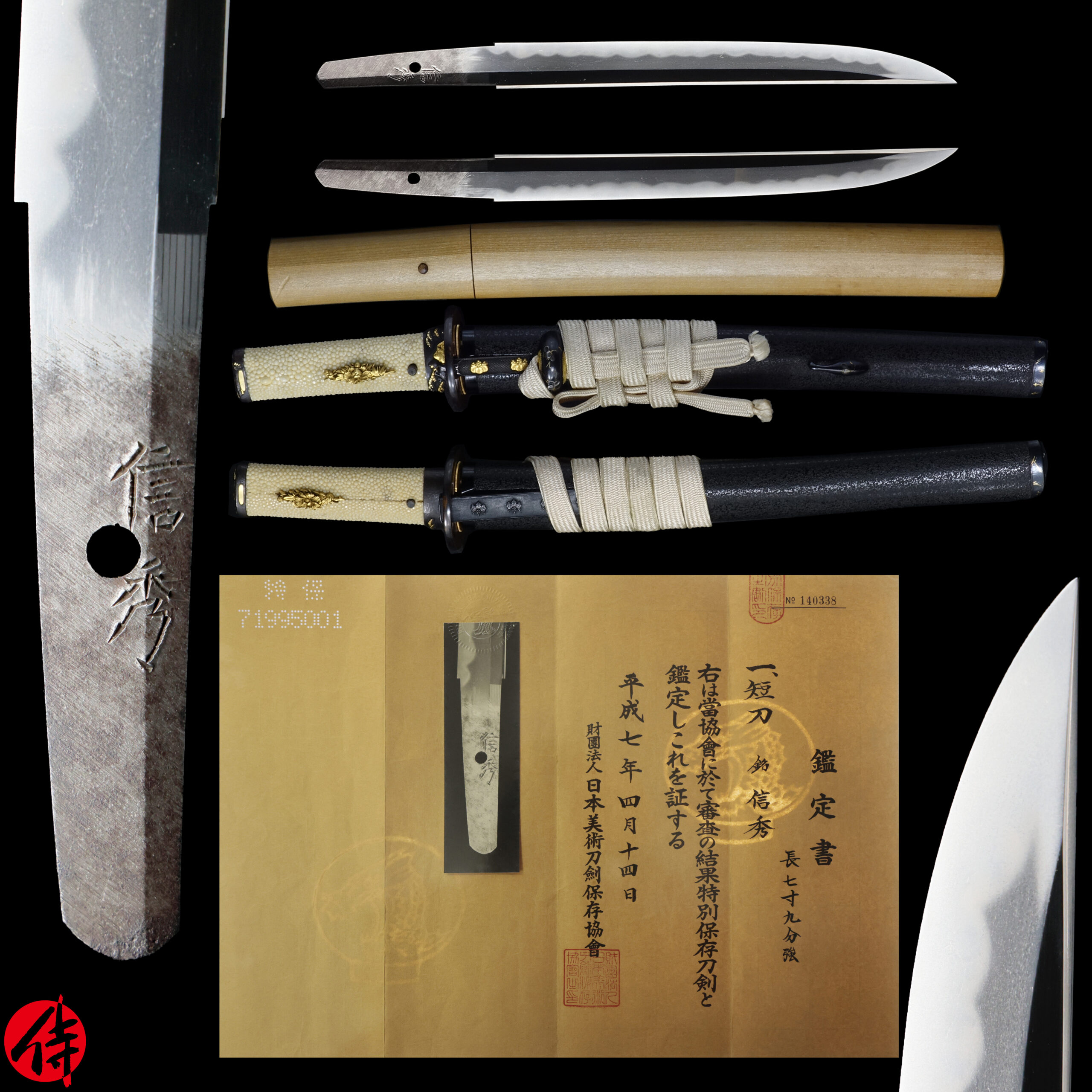
【About us】
Samurai Museum is located in Tokyo, Japan, exhibiting antique artifacts related to the Samurai history. Samurai Museum Shop is the place for those who are interested in Japanese culture and craftsmanship. We deal with antique Samurai swords/armor, traditional crafts made in Japan and so on.
【Japanese Sword& Export Process】
The Japanese swords we deal with are hand-forged edged swords made in Japan. It was made from the traditional carbon steel called TAMAHAGANE(玉鋼). Samurai Museum is familiar with the proper legal procedure for an antique/ authentic Japanese sword to be exported from Japan. We have sent more than 1000 Japanese swords for the past few years (~2025) to amazing owners who appreciate its historical value.
Each Japanese sword is registered under the Agency for Cultural Affairs and the Board of Education in Japan. They issue a registration paper for each Japanese sword for its owner in Japan to legally possess it. The Japanese sword with its registration paper means it was traditionally hand-forged in Japan.
To legally export the sword from Japan to other countries, we will have to apply for its permit to the Agency for Cultural Affairs(Bunkacho) and return the original registration paper to the Board of Education. It normally takes around 2-4 weeks to receive this permit after submitting required documents. And we would like you to expect at least 1-1.5 months for your order to arrive at your given address after you ordered. For more detailed info, please click here.
It is allowed for residents in Japan to own authentic Japanese swords without a special license as long as they come with registration papers. Please feel free to contact us if you are a resident of Japan, whether temporarily or permanently. We will also assist you when you leave Japan and need to obtain the export permit.
【Payment Method】
We accept payment through Stripe (Credit card), PayPal, Apple Pay or ChromePay, all of which are secure payment methods. Also, you don’t need to make an account on Stripe for the checkout. If you prefer other payment method, please contact us. After confirming your payment, we will apply for an export permit. You may either pay in JPY, USD, AUD, CAD,EUR CHF or GBP. The price is set in Japanese Yen. Prices in other currencies are automatically calculated based on the latest exchange rate.

* If the amount is above 1 million JPY, Stripe or wire transfer will be the only options for payment.
【Shipping】
We have shipped authentic Japanese swords to the USA, Canada, Mexico, Germany , Belgium, France, Finland, UK, Hong Kong, Australia. If you don’t live in these countries and like to order, please contact us first before making a purchase. We offer Free International Shipping as long as we can send antique Japanese swords by EMS.
We normally ship by EMS(Express Mail Service) provided by Japan Post. We will send you a tracking number for your order as soon as we hand it to the post office. We will put 100 % insurance on the shipping document without any extra charge. Based on the total amount, there might be a duty tax or other fee for you to pay, depending on the countries. We use package cushioning to protect the item and put it in a PVC pipe, which is one of the most secure packages because of its durability.
It will normally takes 5-14 days for the item to arrive at your given address after we dispatch it. Time of delivery is estimated as accurately as possible by the carrier but does not take into account any delays beyond our control such as by inclement weather, post office holiday seasons.
* If you live in Australia and like to purchase an authentic Japanese sword, please click here to know the detail.
* If you live in the UK and like to purchase an authentic Japanese sword, please contact us first and click here to know the detail.

【Review】
Here is one of the reviews we received from a customer who purchased an authentic Japanese sword from us. For more reviews, please click here.
“My experience overall with the whole process was wonderful. I had many questions about the history and process to purchase these treasures. All my questions were answered very timely and complete. The staff is very knowledgeable and very well versed if any questions do arise.”
【How to make sure the condition】
Please keep in mind that what you are going to purchase is an antique item. We uploaded high resolution photos for you to check its condition thoroughly. If you like to see more photos with different angles, please feel free to contact us. We will be happy to send them to you so that you can make informed decision. It is essential for us to know that you are happy with your choice of a sword. and we are prepared to use the best of our ability to serve you.
【How To Contact Us】
Please contact us through email, Facebook Messenger or Live Chat if you have any questions. You can find each icon on the right side of the website. Please click one of them to reach us. We will reply to you within 1-2 business days.
【The Art of Nihonto (Japanese Sword)】
Samurai’s history is a profound, eloquent legacy of ancient Japanese warriors in which millions of people worldwide are being fascinated. If you like to find out the art of Nihonto, please click here.
【A Guide to Japanese Sword Maintenance】
After acquiring an genuine Japanese sword, it is also important to know how to take good care of it. Here is the special video for you. Mr. Paul Martin, Japanese sword expert, shows you how to give proper maintenance to your sword. By mastering how to clean the Japanese sword, its aesthetic beauty will last forever.
When you purchase a Japanese sword from us, you can get a Free Japanese sword maintenance kit. It comes with four tools(Choji Oil, Uchiko Whetstone Powder, Peg remover, Oil Applicator). By watching the video instruction above , you can enjoy learning how to maintain your Japanese sword while appreciating it. If you have any difficulty assembling the sword or cleaning the blade, you can feel free to contact us.
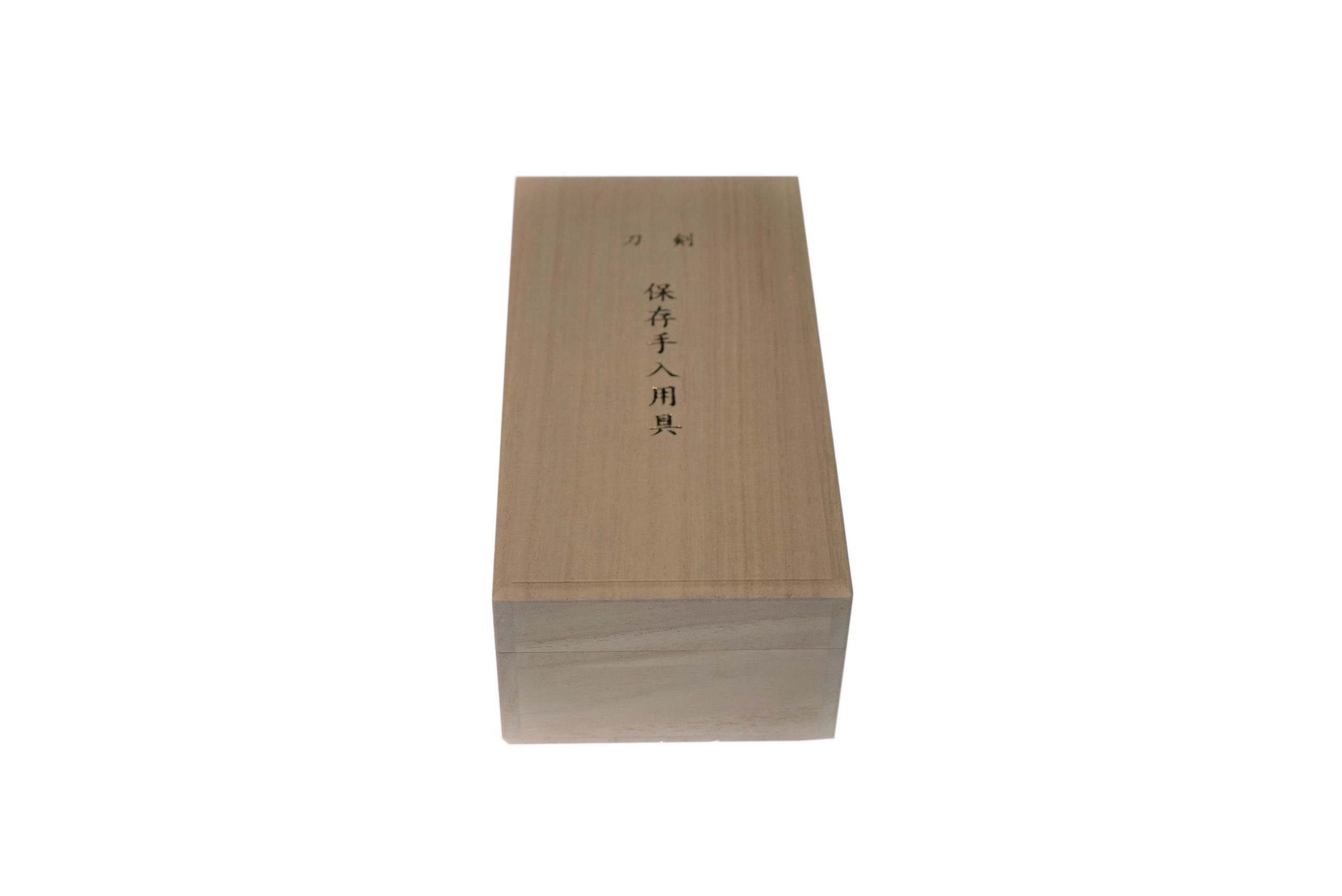
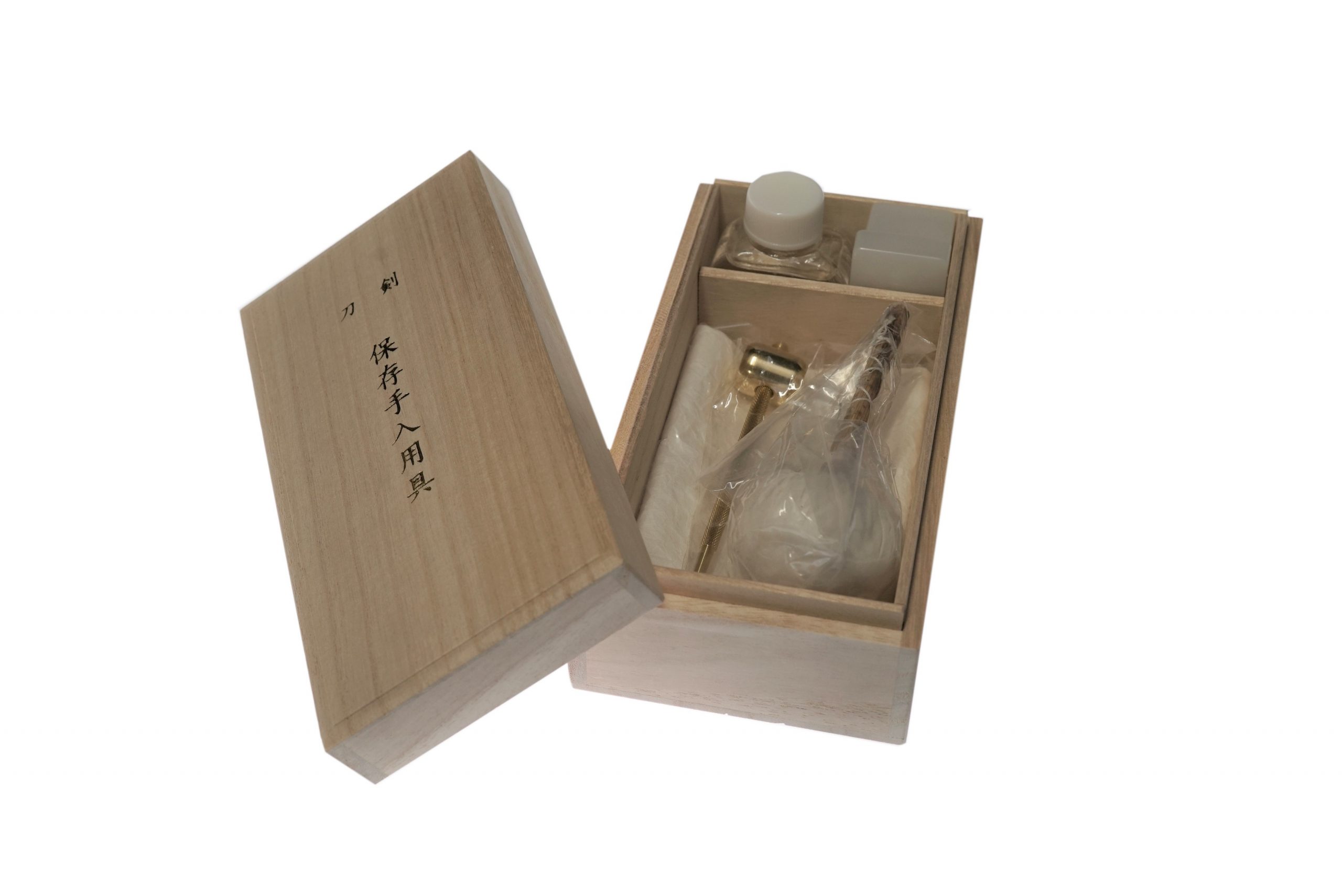
MORE ANTIQUE JAPANESE SWORD FOR SALE
SWORDS WITHOUT CERTIFICATES FOR SALE
LEARN JAPANESE SWORD TERMINOLOGY
Thank you for reading all the information on the page. If you have any difficulty choosing the right Japanese sword for you, we will be more than happy to help you find the one that speaks to you the most. Please feel free to contact us.

